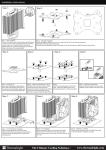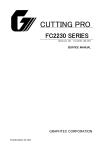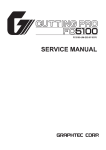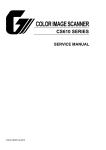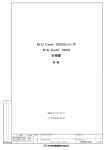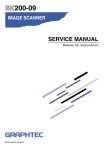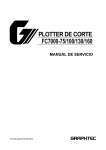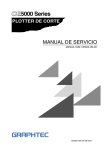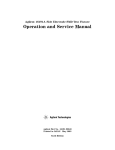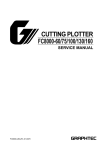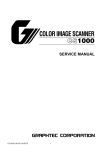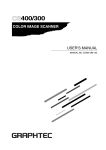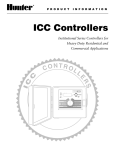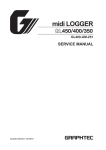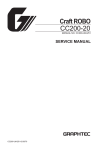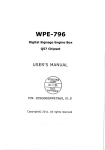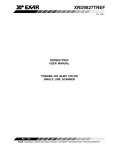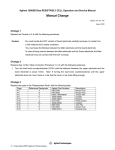Download COLOR IMAGE SCANNER
Transcript
COLOR IMAGE SCANNER CS300/400 SERIES SERVICE MANUAL CS300/400-UM251-04-9370 1 HISTORY OF REVISIONS No. Date issued Description of revision 1 04.04.16 First Printing 2 04.07.04 Part number for the paper hold-down plate corrected 3 05.01.06 Firmware update procedure corrected 4 05.01.14 Part number for the contact glass 3 mm corrected CS300/400-UM-251-9370 i Page All 6-1 9-8 6-1 Edition 01 02 03 04 CONTENTS 1. OVERVIEW............................................................................................ 1-1 1.1 1.2 1.3 Features .............................................................................................................. 1-1 Standard Specifications .................................................................................... 1-2 External View ..................................................................................................... 1-3 2. PART NAMES AND FUNCTIONS ......................................................... 2-1 2.1 Part Names and Functions ............................................................................... 2-1 3. PREPARING TO OPERATE THE SCANNER ....................................... 3-1 3.1 3.2 3.3 3.4 System Requirements ....................................................................................... 3-1 Connecting the Scanner to a Power Supply ................................................... 3-2 Connecting the Scanner to a Computer ..........................................................3-4 Making the Document Hold-Down Unit Force Settings .................................3-6 4. INSTALLING THE SOFTWARE ............................................................ 4-1 4.5 Installing the Scanning Master 21+ Application .............................................4-8 5. DAILY MAINTENANCE ......................................................................... 5-1 5.1 5.2 5.3 5.4 5.5 5.6 Opening and Closing the Top Cover ................................................................ 5-1 Cleaning the Document Hold-Down Unit .........................................................5-2 Cleaning the Image Sensors .............................................................................5-3 Cleaning the Paper Sensors .............................................................................5-4 Removing a Jammed Document ......................................................................5-5 Calibration ..........................................................................................................5-6 6. RECOMMENDED PARTS LIST ............................................................ 6-1 7. LIST OF JIGS AND TOOLS .................................................................. 7-1 7.1 7.2 7.3 8. Jigs ...................................................................................................................... 7-1 Tools.................................................................................................................... 7-1 Other ................................................................................................................... 7-1 DISASSEMBLING AND ADJUSTING THE MECHANICAL PARTS ..................................8-1 8.1 8.2 8.3 8.4 8.5 8.6 8.7 8.8 8.9 8.10 8.11 Right Side Cover ................................................................................................ 8-1 Left Side Cover................................................................................................... 8-1 Center Cover Assembly .................................................................................... 8-2 Front Guide Assembly ....................................................................................... 8-2 Rear Cover ..........................................................................................................8-3 CIS Unit ...............................................................................................................8-4 Motor ...................................................................................................................8-5 Drive Roller Pulley .............................................................................................8-6 Drive Rollers ....................................................................................................... 8-7 Drive Belt ............................................................................................................8-8 Center Cover Sensor .........................................................................................8-9 CS300/400-UM-251-9370 ii 8.12 8.13 8.14 8.15 8.16 8.17 8.18 8.19 8.20 8.21 8.22 8.23 Front and Rear Paper Detection Sensors ...................................................... 8-10 Control Panel Sheet Switch ............................................................................ 8-11 Contact Glass Assembly................................................................................. 8-12 CIS (Charge Coupled Device Imaging Sensor) Assembly ........................... 8-13 CIS (Charge Coupled Device Imaging Sensor) Board .................................. 8-14 Document Hold-down Plate ............................................................................ 8-15 Pinch Roller Units ............................................................................................ 8-17 IEEE 1394 Board .............................................................................................. 8-19 Data Controller Board...................................................................................... 8-20 Data Power Board ............................................................................................8-22 CIS Power Board .............................................................................................. 8-23 Switching Power Supply Board ...................................................................... 8-24 9. BOARDS AND ELECTRICAL COMPONENTS .................................... 9-1 9.1 9.2 9.3 9.4 Wiring Diagrams ................................................................................................ 9-1 Replacing the Data Controller Board ...............................................................9-6 1. Precautions for replacing the data controller board .................................. 9-6 2. Replacing the data controller board ............................................................ 9-6 Replacing the IEEE 1394 Board ........................................................................ 9-7 Input the MAC address to the IEEE 1394 board ............................................. 9-7 Downloading Firmware .....................................................................................9-8 1. Items required to download firmware .......................................................... 9-8 2. Procedure ....................................................................................................... 9-8 10. ADJUSTMENTS USING THE SOFTWARE ........................................ 10-1 10.1 10.2 10.3 10.4 Starting the Software ...................................................................................... 10-1 Preparations before Making Adjustments ..................................................... 10-3 Preparing a Test Chart.....................................................................................10-4 Making Adjustments ........................................................................................10-5 Scanner Calibration......................................................................................... 10-5 1. Calibration (white correction) ..................................................................... 10-5 2. Feed distance adjustment .......................................................................... 10-7 3. Position adjustment .................................................................................... 10-9 4. Color correction (using a color correction sheet)...................................10-15 11. TROUBLESHOOTING ........................................................................ 11-1 12. SCHEMATIC DIAGRAMS ................................................................... 12-1 12.1 12.2 12.3 12.4 12.5 Data Controller Board...................................................................................... 12-1 CIS Controller Board ..................................................................................... 12-16 Data Power Board .......................................................................................... 12-20 CIS Power Board ............................................................................................ 12-22 Relay Board .................................................................................................... 12-23 CS300/400-UM-251-9370 iii 12.6 IEEE 1394a Board .......................................................................................... 12-24 13. OPTION ............................................................................................... 13-1 13.1 Optional Items .................................................................................................. 13-1 13.2 Consumables ................................................................................................... 13-1 14. PARTS LIST ........................................................................................ 14-1 14.1 14.2 14.3 14.4 14.5 14.6 14.7 14.8 14.9 Outer Casing .................................................................................................... 14-1 Main Frame ....................................................................................................... 14-2 Front Guide .......................................................................................................14-4 Drive Roller .......................................................................................................14-6 CIS Unit .............................................................................................................14-8 Center Cover .................................................................................................. 14-10 Hold-down Unit .............................................................................................. 14-12 Cables ............................................................................................................. 14-14 Other Parts ..................................................................................................... 14-14 CS300/400-UM-251-9370 iv 1. OVERVIEW 1. OVERVIEW 1.1 Features • 600-dpi optical resolution for high-precision image scanning Scanning with an optical resolution of 600 dpi allows even complex and difficult-to-scan documents, such as CAD drawings, electronic files, and mapping data to be scanned rapidly and with high precision. Scanning Master 21+ (scanner software included as a standard accessory) can be used to adjust the resolution in five levels (50 dpi to 800 dpi, in 1-dpi increments) to suit the scanned document. • Compatible document widths range from 210 mm to 1016 mm Compatible with document sizes from ISO A4 up to ANSI E • Capable of color and grayscale scanning Capable of scanning in color (24-bit color*, 8-bit color) or grayscale (256 shades) * CS400 only • Capable of reading long-axis data Scanning of long-axis images is supported. • Compact and lightweight design A compact design was achieved by using a document travel system that employs contact image sensors in the sensor unit (five rows arranged in a zigzag pattern). • Image-processing functions Use of the scanning software provided lets you set image-processing functions for the scanning of a document. • Interface USB 2.0, IEEE 1394 CS300/400-UM-251-9370 1-1 1. OVERVIEW 1.2 Standard Specifications Item CS400 CS400 Document size ANSI E to ISO A4 Maximum width: 1090 mm; minimum width: 210 mm Effective scanning area Width : 1016 mm (centered) Length : 16 m*1 Guaranteed scanning precision range*3 841 mm x 1189 mm Document thickness 1.5 mm or less (including the carrier sheet) Optical resolution 600 dpi Interpolated resolution 50 to 800 dpi, in 1-dpi increments Main scanning system Contact image sensor system (Five A4 sensors in a zigzag pattern) Sub scanning system Document travel (sheet through) system Scanning speed*2 Monochrome: Approx. 0.55 ms/line 9 inch/s at 400 dpi Color: Approx. 1.65 ms/line 3 inch/s at 400 dpi Scanning precision*3 ±0.1%, ±5 pixels Gradation Monochrome: Bilevel, intermediate tones (dithering, error diffusion) Gray : 256 shades Color: 8-bit, 24-bit 8-bit Threshold value Digital signal processor enable automatic setting of the threshold value (monochrome scans only) Color space sRGB compatible Light source LED (RGB) Interface*3 USB 2.0, IEEE 1394 Output Image data Rated power supply 100 to 120/200 to 240 VAC ±10%, 50/60 Hz Operating environment Temperature: 10˚C to 35˚C Humidity: 35% to 80% RH (no condensation) Power consumption 135 VA or less (60 W or less) External dimensions (approx.) 1205 X 957 X 715 mm (WXHXD) (including stand) Weight Approx. 40 kg (including stand) * 1 Documents up to approximately 16 m in length (driver software limitation) can be scanned. However, the actual document length that can be scanned is limited by the available memory (hard disk or other data storage device) of the computer to which the scanner is connected, and also by the grade of the medium being scanned. 2 * Excluding data-transfer time * 3 Notes on scanning precision Scanning precision may vary slightly depending on the grade and thickness of the medium being scanned, and on the operating conditions. The precision figures above were measured under the operating conditions described below. • Test chart used : Mylar sheet #200 • Guaranteed precision conditions : Temperature 20 ±3˚C; humidity: 60% ±10% RH • Document hold-down unit setting : Standard * 4 The USB 2.0 and IEEE 1394 interface cannot be used at the same time. CS300/400-UM-251-9370 1-2 1. OVERVIEW 1.3 External View 957 External Dimensions 715 1205 Unit : mm Dimensional precision error : ±5 mm Note: The diagrams are of the CS400 model. CS300/400-UM-251-9370 1-3 2. PART NAMES AND FUNCTIONS 2. PART NAMES AND FUNCTIONS 2.1 Part Names and Functions Front View Paper sensor Control panel Top cover Cover sensor Document guides * The CS300 document guides are the magnetic guides supplied as standard accessories. Lock Basket Stand Release Caster Top cover Open the top cover to clean the document hold-down unit and transparent contact plates. Paper sensors These sense whether a document is present in the scanner. Cover sensor This senses whether the top cover is open or closed, and interrupts scanner operation if the top cover is opened during operation. Document guides Use these guides to determine the position of a document when you load the document. These guides are a sliding type for the CS400 and a magnetic type for the CS300. Control panel Use the keys to operate the scanner and the LEDs to monitor the operating status. Stand The stand unit is assembled for mounting of the scanner unit. Basket Receives the document that has been scanned. Casters Release the lock on the casters to allow the unit to be moved. Do not touch the cover sensor or paper sensor. CS300/400-UM-251-9370 2-1 2. PART NAMES AND FUNCTIONS Front View Power switch IEEE 1394 connector AC line inlet USB connector Power switch Controls the on/off status of the power supply to the scanner. AC line inlet Connect the power cord’s female plug here. USB connector Used to connect the USB interface cable. IEEE 1394 connector The USB and IEEE 1394 connectors cannot be used at the same time. Do not connect both the USB and IEEE 1394 cables to a computer, or to two separate computers, at the same time. CS300/400-UM-251-9370 2-2 2. PART NAMES AND FUNCTIONS Control panel POWER PAPER ERROR SCAN POWER LED Unlit Lit (green) : Is unlit while the scanner is turned off. : Lights when the scanner is turned and remains lit while it is operating normally. Flashing (orange) : Flashes when the scanner is in power-saving mode. PAPER LED FORWARD REVERSE STOP Unlit : Normal status (Local status). Lit (green) : Lights when the scanner enters Scan READY status. Flashing (green) : Flashes while image data is being scanned. ERROR LED Lit (red) Flashing (red) : Lights to indicate a hardware error. : Flashes when a document is detected during the selftest when the scanner is turned on; when scanning is suspended by pressing the STOP key; when a paper jam is detected; or when the document length is shorter than the specified scan length.* Unlit : Normal status (* When "Confirm" has been selected for the End-of-paper Processing setting in the Scanning Master 21+ driver.) SCAN key This key enables you to scan a document according to the settings of Scanning Master 21+ when the scanner is connected to a computer. Start up Scanning Master 21+ before scanning a document if it is not already active. FORWARD key Advances the document into the scanner. When this key is pressed in Scan READY status, the Scan READY status is cancelled and the document is ejected toward the rear of the scanner. REVERSE key Feeds the document toward you. When this key is pressed in Scan READY status, the Scan READY status is cancelled and the document is ejected toward the front of the scanner. STOP key Compulsorily stops scanning of the document. CS300/400-UM-251-9370 2-3 3. PREPARING TO OPERATE THE SCANNER 3. PREPARING TO OPERATE THE SCANNER 3.1 System Requirements The minimum system requirements for running the scanner’s hardware and software are listed below. Operating system: Windows 2000 Professional/XP Professional/9XP Home Edition CPU: Pentium III/4 Memory: 32 MB or more Monitor: 1024 × 768 pixels, 256 colors or more Enough disk space to store data Mouse USB 2.0 interface*1 (that comes standard with your computer) or IEEE 1394 interface*2 *1 If your scanner does not operate with the USB interface that comes with your computer, or if your computer does not have a USB 2.0 interface, please contact your sales representative or nearest Graphtec vendor for information on supported add-on cards. *2 Graphtec does not guarantee correct scanner operation with every IEEE 1394 computer interface or add-on card. Please contact your sales representative or nearest Graphtec vendor for information on supported add-on cards. Recommended environment For binary monochrome data CPU: Pentium 200 MHz or higher Memory: 64 MB or more USB 2.0 interface (that comes standard with your computer) For grayscale data CPU: Pentium III 550 MHz or higher Memory: 256 MB or more Monitor: 1024 × 768 pixels, High Color or higher resolution USB 2.0 interface (that comes standard with your computer) For 8-bit/24-bit color data CPU: Pentium 4 Memory: 512 MB or more Monitor: 1024 × 768 pixels, True Color or higher USB 2.0 interface (that comes standard with your computer) The system configuration should correspond to the recommended specifications listed here, in order to ensure the optimum capabilities of the scanner. Use with a system configuration below the recommended specifications will affect the scanning speed and prevent the scanner from operating to its specified capabilities. To edit an A1-size or larger grayscale document with a resolution of 400 dpi or higher, or color document, you may need more than the recommended memory sizes above. Depending on the type of document, you may not be able to scan in the document even if you increase the memory size. CS300/400-UM-251-9370 3-1 3. PREPARING TO OPERATE THE SCANNER 3.2 Connecting the Scanner to a Power Supply Insert the female plug of the power cord provided into the scanner’s AC line inlet and insert its male plug into an electrical socket supplying AC voltage. Check that the scanner’s Power switch remains in the Off position until the connection of the power cord has been completed. Ensure that the scanner’s Power switch is in the Off position. Make sure that your scanner is properly grounded. If it is not grounded, there is a possibility that noise will cause incorrect operation, or that the scanned image may be distorted. CS300/400-UM-251-9370 3-2 3. PREPARING TO OPERATE THE SCANNER Turning the Scanner On or Off Whenever the scanner's Power switch is turned on, the POWER, PAPER, and ERROR lamps on the control panel light up. When the scanner has been initialized, the POWER lamp lights up. When resetting the scanner by turning it off then back on again, wait at least five seconds before turning it back on. CS300/400-UM-251-9370 3-3 3. PREPARING TO OPERATE THE SCANNER 3.3 Connecting the Scanner to a Computer The scanner can be connected to a computer using the USB interface or IEEE 1394 interface. The operation of the scanner cannot be guaranteed in the following cases: • When the cable is connected to a USB hub or an add-on USB board. • When you are using a custom-built computer or one that you have modified. The following should never be attempted: • Remove or reinsert the cable while you are installing the driver. • Remove or reinsert the cable while starting up the computer or the scanner. • Remove or reinsert the cable within a period of 5 seconds. • Remove or reinsert the cable while transferring data. • Connect two or more scanners to a single computer. The USB and IEEE 1394 connectors cannot be used at the same time. Do not connect both the USB and IEEE 1394 cables to a computer, or to two separate computers, at the same time. Connecting the scanner via a USB 2.0 interface (1) Ensure that you have a USB 2.0 interface cable that works with your computer. Plug the USB 2.0 interface cable into the USB connector socket situated on the right-hand side of the scanner unit. USB connector To the computer USB 2.0 CS300/400-UM-251-9370 3-4 3. PREPARING TO OPERATE THE SCANNER Connecting the scanner via an IEEE 1394 interface (1) Ensure that you have an IEEE 1394 interface cable that works with your computer. Plug the IEEE 1394 interface cable (6-pin) into the IEEE 1394 connector socket situated on the right-hand side of the scanner unit. IEEE 1394 connector IEEE 1394 (6-pin) connector CS300/400-UM-251-9370 IEEE 1394 interface cable 3-5 To the computer 3. PREPARING TO OPERATE THE SCANNER 3.4 Making the Document Hold-Down Unit Force Settings Changing the position of the lever at the right side of the top cover enables you to switch between two holddown force settings. Use this facility according to the status of the document to be scanned. Standard High High .............. Use this setting with: • Plain paper with a thickness of 0.8 mm or higher • Documents with creases or strongly curled documents where the creases or curl affect the scanning quality Standard ...... This mode is normally used to scan a document. • Do not use the “High” setting with paper less than 0.8 mm thick or with fine or limp documents, as the document may become damaged or jammed in the scanner. The “High” setting has a stronger hold-down force than that of the “Standard” setting, and may cause damage to thin documents. In addition, because the precision accuracy also differs, a distance correction operation may need to be performed when you switch from one setting to the other. • Use the carrier sheet when scanning film documents or similar. • Be sure to use the “Standard” setting with photographs or other documents that have a glossy surface. If you use the “High” setting, the document may stick to the scanner glass and adversely affect the scanning quality. • Always ensure that you check the lever status before using the scanner, because the modes may switch if the scanner has been subjected to a strong vibration as a result of being dropped or shaken. CS300/400-UM-251-9370 3-6 4. INSTALLING THE SOFTWARE 4. INSTALLING THE SOFTWARE The procedure outlined below is based on the requirement that you are logged on to Windows with administrator rights. Consult your Windows 2000 or Windows XP manual for more information. 4.1 Installing the Driver Software for Windows 2000 The following procedure assumes that you are using the CS400 as part of your system, and that you are using the USB interface. If you are using the IEEE 1394 interface, GRAPHTEC CS400-10 IEEE 1394 SBP2 Device will be displayed where CS400-10 is displayed when the USB interface is used. Substitute CS300-10 for CS400-10 for guidelines as to how to use the CS300. (1) Connect the scanner to the computer, and turn on the computerʼs power. Insert the CD-ROM disk (included with your computer) into the CD-ROM drive of the computer after Windows has started up, and then turn on the scannerʼs power. (2) The message below appears. (3) Next, the Found New Hardware Wizard appears. (4) Click the Next button to proceed to the menu for installing the driver. CS300/400-UM-251-9370 4-1 4. INSTALLING THE SOFTWARE (5) Select the option “Search for a suitable driver for my device (recommended)” and click Next. (6) Select the check box entitled “Specify a location” and click Next. Click Browse and select the DRIVER folder in the CD-ROM drive or enter a CD-ROM drive name and \DRIVER using the keyboard. Example: For drive E, enter “E:\DRIVER.” (7) When you click OK the wizard will start searching for the driver. The screen shown below is displayed when the wizard has finished searching. CS300/400-UM-251-9370 4-2 4. INSTALLING THE SOFTWARE (8) The screen shown below is displayed when you click Next. Click Yes to continue the installation. (9) The screen shown below is displayed when the wizard has finished installing the driver. Click the Finish button. (10) The Windows 2000 Desktop appears and the Scanner is acknowledged by the computer. CS300/400-UM-251-9370 4-3 4. INSTALLING THE SOFTWARE 4.2 Installing the Driver Software for Windows XP The following procedure assumes that you are using the CS400 as part of your system, and that you are using the USB interface. If you are using the IEEE 1394 interface, GRAPHTEC CS400-10 IEEE 1394 SBP2 Device will be displayed where CS400-10 is displayed when the USB interface is used. Substitute CS300-10 for CS400-10 for guidelines as to how to use the CS300. (1) Connect the scanner to the computer, turn on the scanner first, and then turn on the computer. When Windows starts up, insert the CD-ROM supplied with the scanner in the CD-ROM drive. Turn on the power to the scanner. (2) When Windows XP starts up, the following window appears. (3) Next, the Found New Hardware Wizard window appears. Select the option “Install from a list or a specific location (Advanced)”. (4) The screen shown below is displayed when you click Next. Select the option “Search for the best driver in these locations” and select the check box entitled “Include this location in the search”. Click Browse and select the DRIVER folder in the CD-ROM drive or enter a CD-ROM drive name and \DRIVER using the keyboard. Example: For drive E, enter “E:\DRIVER.” CS300/400-UM-251-9370 4-4 4. INSTALLING THE SOFTWARE (5) When you click Next the wizard will start searching for the driver. (6) The screen shown below is displayed. Click Continue Anyway to continue the installation. (7) The screen shown below is displayed when the wizard has finished installing the driver. Click the Finish button to close the “Welcome to the Found New Hardware” wizard. (8) The Windows XP desktop appears, and the scanner is recognized by the computer. CS300/400-UM-251-9370 4-5 4. INSTALLING THE SOFTWARE 4.3 Checking the Interface Connection for Windows 2000 The procedure outlined below assumes that the CS400 is connected in your system. Substitute CS300-10 for CS400-10 for guidelines as to how to use the CS300. (1) Launch the Control Panel using the Start menu. (2) The screen shown below is displayed when you click on the “Scanners and Cameras” icon. Ensure that “Graphtec CS400-10 or CS300-10” is indicated here. CS300/400-UM-251-9370 4-6 4. INSTALLING THE SOFTWARE 4.4 Checking the Interface Connection for Windows XP The procedure outlined below assumes that the CS400 is connected in your system. Substitute CS300-10 for CS400-10 for guidelines as to how to use the CS300. (1) Launch the Control Panel using the Start menu. (2) The screen shown below is displayed when you click on the “Printers and Other Hardware” icon. (3) The screen shown below is displayed when you click on the “Scanners and Cameras” icon. Ensure that “Graphtec CS400-10” or “Graphtec CS300-10” is indicated here. CS300/400-UM-251-9370 4-7 4. INSTALLING THE SOFTWARE 4.5 Installing the Scanning Master 21+ Application The Scanning Master 21+ “OPS112” is a software application for using a Graphtec scanner to scan image data. Operating Environment Windows 2000 Professional/XP Professional/XP Home Edition Installation Procedure (The following steps are explained using the Windows 2000 windows.) (1) Boot Windows 2000. (2) Insert the User Guide CD-ROM containing the OPS112 program files into the computer’s CD-ROM drive. (3) Click the Taskbar’s Start button, then click the Run... icon. (4) Enter the CD-ROM drive name and English\OPS112\SETUP.EXE as the name of the file you wish to open. If the disk is in drive E, for example, enter “E:\English\OPS112\SETUP.EXE” in the box. (5) Click the OK button to run the OPS112 setup program. From this point on, follow the setup programʼs instructions to install the OPS112 application. • If the application has been properly installed, “Scanning Master 21+” will be newly listed in the Program menu accessed from the Start button. For more details, open the README.TXT file provided in the “Scanning Master 21+” folder. CS300/400-UM-251-9370 4-8 5. DAILY MAINTENANCE 5. DAILY MAINTENANCE 5.1 Opening and Closing the Top Cover (1) Turn off the scanner’s power. (2) Push the left and right open levers on the top cover to unlock them, and hold the middle part of the top cover while you open the top cover by about 90 degrees. Open levers Top cover (3) Close the top cover until the left and right latches on the top cover lock into position, making sure that you don’t get your fingers caught. CS300/400-UM-251-9370 5-1 5. DAILY MAINTENANCE 5.2 Cleaning the Document Hold-Down Unit (1) Turn off the scanner. (2) Open the top cover as described in Section 5.1 “Opening and Closing the Top Cover”. Document hold-down unit Latch Latch (3) Wipe clean the underside of the document hold-down unit (see below) using a soft cloth that has been soaked in water or diluted neutral detergent and thoroughly wrung out. (4) Wipe the document hold-down unit once again using a soft, dry cloth (remove all moisture). (5) Close the top cover as described in Section 5.1 “Opening and Closing the Top Cover”. Take care not to get your fingers caught in the cover. Scanning may be affected if the underside of the document hold-down unit becomes scratched or dirty. It must be cleaned when necessary. CS300/400-UM-251-9370 5-2 5. DAILY MAINTENANCE 5.3 Cleaning the Image Sensors The scanner’s image quality drops when the transparent contact plates over the image sensors become dirty, so clean the image sensors whenever necessary. Procedure (1) Turn off the scanner. (2) Open the top cover as described in Section 5.1 “Opening and Closing the Top Cover”. (3) As shown below, wipe off any soiled areas on the transparent contact plates using a soft cloth that has been moistened with water or a neutral detergent (diluted with water) and firmly wrung out. Transparent contact plates (4) Completely remove any moisture on the transparent contact plates by wiping them off again using a soft, dry cloth. (5) Close the top cover as described in Section 5.1 “Opening and Closing the Top Cover”. Take care not to get your fingers caught in the cover. Do not use a commercial cleaner for office equipment, a glass cleaner, or chemical solvents such as solutions containing alcohol. Although the glass scanning table is not a maintenance part that requires periodic replacement, it is a consumable part because its surface may receive slight scratches due to minute particles of dust and other foreign matter. If document scanning produces unsatisfactory results (unexpected white or black streaks in the data) due to scratches on the glass table or other reasons, please perform the calibration procedure (see Section 5.4, “1. Calibration”). If the scanning results do not improve after calibration, the glass table will need to be replaced. CS300/400-UM-251-9370 5-3 5. DAILY MAINTENANCE 5.4 Cleaning the Paper Sensors Accumulated dust on the paper sensors may prevent the document from being detected. The sensors must be cleaned when necessary. (1) Turn off the scanner. (2) Open the top cover as described in Section 5.1 “Opening and Closing the Top Cover”. (3) Wipe the two paper sensors using a cotton swab. Paper sensors (4) Close the top cover as described in Section 5.1 “Opening and Closing the Top Cover”. Take care not to get your fingers caught in the cover. Use a cotton swab or something equally soft to gently wipe the paper sensors. Do not use any chemicals to clean the sensors. CS300/400-UM-251-9370 5-4 5. DAILY MAINTENANCE 5.5 Removing a Jammed Document If a document becomes jammed in the scanner during scanning or another operation, immediately turn off the scanner, remove the document hold-down unit, and then remove the jammed document. Procedure (1) Turn off the scanner. (2) Open the top cover as described in Section 5.1 “Opening and Closing the Top Cover”. (3) If the document is jammed at the front, remove the document from the inside or by pulling it forward. (4) If the document is jammed at the rear, remove the document from the inside by pulling it toward the rear. (5) Close the top cover as described in Section 5.1 “Opening and Closing the Top Cover”. Take care not to get your fingers caught in the cover. CS300/400-UM-251-9370 5-5 5. DAILY MAINTENANCE 5.6 Calibration Calibrate the scanner if scanning quality is observed to deteriorate, with scanned results such as those described below: • The scanned image is distorted • Areas of uneven color appear in the scanned image • Other unsatisfactory results (but not including problems related to media quality, such as folds, wrinkling, or paper curling) • Handle the calibration sheet with care so that it does not get bent. To prevent soiling, store it in its special storage box. The calibration sheet cannot be used if it is bent or soiled. • The calibration sheet is a paper product. Do not attempt to clean it with any type of liquid cleaner. • The calibration sheet is a consumable item. Replacement sheets can be purchased from your sales representative or nearest Graphtec vendor. Preparation and checks Recommended usage environment • Monitor: 1024 x 768 pixels, High Color or better resolution A low-resolution monitor will make it difficult to discern any problem areas. Launching the Scanner Adjustment Program (1) (2) (3) (4) Connect the scanner to the PC and switch on the scanner. Switch on the PC. Install Scanning Master 21+ (OPS112) if it is not already installed. Click the Start button, then select Programs > Scanning Master 21+ > Scanner Adjustment. Click Scanner Adjustment to launch the Scanner Adjustment program. CS300/400-UM-251-9370 5-6 5. DAILY MAINTENANCE Scanner Calibration Before beginning calibration, clean the transparent contact plates and scanner table surface. Any dust or dirt on this surface may affect calibration results and resulting image quality. Check that the calibration sheet is free of any dust or dirt. The calibration procedure will take some time. Do not switch off the scanner while calibration is underway. Accidentally switching off the scanner may result in damage that requires servicing. (1) Connect the scanner to the computer. Switch on the scanner, then switch on the PC. (2) Launch the Scanner Adjustment program (as described earlier). (3) Select Model Setup on the Scanner menu. (4) Select the connected scanner and click the OK button. (5) Select Calibration on the Scanner menu. (6) Select All in Calibration and click the Execute button. (7) The following message is displayed. Insert the calibration sheet into the scanner as instructed. (8) Clicking the OK button begins calibration. (9) Calibration ends after approximately 10 minutes. Click the OK button to complete calibration. CS300/400-UM-251-9370 5-7 5. DAILY MAINTENANCE (10) To check the calibration results, click the Confirm button in the Calibration menu (shown in step (5) above). (11) The following message is displayed. Insert the calibration sheet into the scanner as instructed. (12) Click the OK button to start scanning. The scanned data is displayed when scanning is complete. Colors may differ slightly for individual sensors to make it easier to identify problem areas in calibration. This does not indicate a defect. Check that there are no vertical streaks, such as white patches, in the scanned data. (Streaks occur when calibration is not performed correctly due to contamination by dust or dirt.) (13) If the data is normal, calibration is complete. Click the Close button and exit the Scanner Adjustment Program. (14) If any abnormal data is observed, specify the problem areas as follows: Select Specified Part in Calibration. (15) The mouse arrow cursor changes to a cross cursor when moved over the data. Click the left mouse button with the mouse positioned over the streak data. The selected area is shown in blue. Repeat this procedure for any additional streaks. Areas that have been selected (shown in blue) can be deselected by clicking the left mouse button again. To deselect all selected areas, click the Clear button. (16) Once all required areas have been specified, remove the calibration sheet and clean the glass and table surfaces. Check the calibration sheet for dust and dirt, then click the Execute button. (17) Return to step (10) and verify the calibration results. CS300/400-UM-251-9370 5-8 5. DAILY MAINTENANCE Color Correction Perform color correction if there is any discrepancy in color in parts of the scanned image even after you have calibrated the scanner. (1) Select Color Correction on the Scanner menu. (2) Click the Scan button. (3) The following message is displayed. Insert the color correction sheet in the scanner. Position the color correction sheet so that the red bar in the center of the sheet is centered in the scanner (but with the printed side down). (4) Click the OK button to start scanning. The scanned data is displayed when scanning is complete. Colors may differ slightly for individual sensors, but this does not indicate a defect. (5) When the data is displayed, click the Get button. (6) Click in the center of the color tile indicated by the numbers 1 to 6, in ascending order. For numbers 1 to 5, click the center of the upper left tile; for number 6, click in the center of the bottom right tile. Align the cursor crosshairs with the printed lines at the sides of the tile. Cursor lines (red) Align with the printed lines, then click. • The next reference point to be checked is displayed on the Status bar. • If you click in error, click the Esc. key to cancel the operation and return to the immediately previous step. • If you click on the wrong tile, color correction will not be performed correctly and the colors of the image displayed after color correction will be incorrect. CS300/400-UM-251-9370 5-9 5. DAILY MAINTENANCE (7) After you have clicked tile number 6, click the Set button. Click the OK button. (8) To check the color correction results, click the Confirm button. (9) The following message is displayed. Insert the color correction sheet in the scanner as instructed. Position the color correction sheet so that the red bar in the center of the sheet is centered in the scanner (but with the printed side down). (10) Click the OK button to start scanning. After scanning has been completed, an enlarged view of the color-corrected data is displayed. (11) Click the Fit icon to display the entire image, and check whether there is any discrepancy in color. If there is no discrepancy, color correction is complete. Click the Close button. If there is still some color discrepancy after performing Color Correction, repeat steps (6) through (11). CS300/400-UM-251-9370 5-10 6. RECOMMENDED PARTS LIST 6. No. 1 2 3 4 5 6 7 8 9 10 11 12 13 14 15 16 17 18 19 20 21 22 23 24 25 26 27 28 29 30 31 32 33 34 35 36 RECOMMENDED PARTS LIST Part No. 774015500 774015501 774015502 774015503 774015504 774015505 694500780 694500790 694500800 694500811 694500830 694500840 694500850 694500860 694500870 694500880 500051795 500051794 308004002 641300000 500051793 502112009 502210002 502211000 694450052 500051630 314690020 341511001 378020021 774015027 641300130 641300633 641300100 641300110 641300050 641400050 Part Name Data Controller Board CIS Controller Board Data Power Board CIS Power Board Motor Drive, 3-phase IEEE 1394 Board CIS Power Board Cable Data Controller Board Power Cable Motor Controller Board Power Cable Motor (3-phase) Cable Motor Controller Cable Switching Power Board to Power Board Cable Primary Power Cable CIS Board to Data Board Cable Sensor Cable Inlet to Power Switch Cable CIS Sensor Motor Motor Damper Control Panel Inlet Power Switch Paper Sensor Cover Sensor Fan Switching Power Board Bearing O Ring Drive Belt Contact Glass 3mm Drive Roller Paper Hold-down Plate Pinch Roller Pinch Roller Shaft Front Guide CS400 Front Guide CS300 CS300/400-UM-251-9370 6-1 Description Q'ty Remarks 1 5 1 1 1 1 3SB-2C-1 5 3SB-2C-2 1 3SB-2C-3 1 3SB-2C-4A 1 3SB-2C-6 1 3SB-2C-7 1 3SB-2C-8 1 3SB-2C-9 5 3SB-2C-10 1 3SB-2C-11 1 CIPS218CF601 5 KT60KM06-551 1 MOTOR MOUNT RF2600-A5 1 3SB CONTROL PANEL 1 FN-9222R-3-06 1 AJ7201B 1 PS-R50L-A 2 GP1A05A 1 CS2000C-6A 1 ZWS75AF-24/J 1 6900ZZNXR 4 SAME AS CS2000 1AP12 12 SAME AS CS2000 BELT 60S2M400 1 CONTACT GLASS 3mm 1 DRIVE ROLLER 2 CS-JEC 1 SAME AS CS2000 PINCH ROLLER G 4 SHAFT 1 FRONT GUIDE FOR CS400 1 FRONT GUIDE FOR CS300 1 7. LIST OF JIGS AND TOOLS 7. LIST OF JIGS AND TOOLS 7.1 Jigs Jigs argos.X OPS112 (Ver. 4.40 or later) Adjustments •Downloading system program •Downloading system program Remarks Firmware (CS400/300.X) Software supplied with the scanner •Shading (white correction) (Scanning Master 21+) •Adjusting feed distance •Aligning sensor images •Adjusting offset Calibration sheet •Color correction •Shading (white correction) Color correction sheet CS1000 adjustment test chart •Replacing main board •Color correction •Adjusting feed distance Standard accessory 1050 mm x 200 mm Standard accessory Record measured values between a and •Adjusting offset c, b and d, a and b, c and d, a and d, and •Aligning sensor images b and c. Screwdriver Usage Disassembly, reassembly, and other Remarks Large, medium, and small flat blade Allen wrench operations screwdrivers and Phillips screwdrivers Needle-nose pliers Colex gauge Multimeter Adjusting belt tension Checking voltage level 200g / 4 mm displacement 7.2 Tools Tools 7.3 Other Item Water-diluted neutral detergent or Cleaning Usage absolute ethanol wiper (cloth) PC Used to determine whether the problem USB cable is caused by the scanner or any other equipment. CS300/400-UM-251-9370 7-1 Remarks 8. DISASSEMBLING AND ADJUSTING THE MECHANICAL PARTS 8. DISASSEMBLING AND ADJUSTING THE MECHANICAL PARTS 8.1 Right Side Cover Detaching the right side cover (1) Remove the three M4L6 binding head screws on the right side of the scanner unit. (2) Detach the right side cover as shown below. M4L6 Binding Head Screw J3 Right Side Cover (3) Disconnect the connector J3 from the data power board. Reattaching the right side cover (1) Reattach the right side cover in the reverse order in which it was detached. 8.2 Left Side Cover Detaching the left side cover (1) Remove the three M4L6 binding head screws on the left side of the scanner unit. (2) Detach the left side cover as shown below. M4L6 Binding Head Screw Left Side Cover Reattaching the left side cover (1) Reattach the left side cover in the reverse order in which it was detached. CS300/400-UM-251-9370 8-1 8. DISASSEMBLING AND ADJUSTING THE MECHANICAL PARTS 8.3 Center Cover Assembly Detaching the center cover (1) Detach the right and left side covers (see Sections 8.1 and 8.2). (2) Remove the four M3L10 cap screws and the two M3L14 cap screws on both sides of the plate. (3) Detach the center cover assembly from the scanner unit as shown below. Center Cover Assembly M3L10 Cap Screw M3L10 Cap Screw M3L14 Cap Screw M3L14 Cap Screw Reattaching the top cover (1) Reattach the top cover in the reverse order in which it was detached. 8.4 Front Guide Assembly Detaching the front guide assembly (1) Detach the right and left side covers (see Sections 8.1 and 8.2). (2) Remove the four M3L6 binding head screws holding the front guide assembly from each side. (3) Detach the front center guide assembly as shown below. M3L6 Binding Head Screw M3L6 Binding Head Screw Front Guide Assembly CS300 does not have this paper guide. Reattaching the front guide assembly (1) Reattach the front guide assembly in the reverse order in which it was detached. When reattaching the front guide assembly, make sure that the front guide assembly does not touch the front drive roller. CS300/400-UM-251-9370 8-2 8. DISASSEMBLING AND ADJUSTING THE MECHANICAL PARTS 8.5 Rear Cover Detaching the rear cover (1) Remove the four M3L6 binding head screws at the back of the scanner unit. M3L6 Binding Head Screw (2) Detach the rear cover. Reattaching the rear cover (1) Reattach the rear cover in the reverse order in which it was detached. When reattaching the rear cover, make sure that the rear cover does not touch the rear drive roller. CS300/400-UM-251-9370 8-3 8. DISASSEMBLING AND ADJUSTING THE MECHANICAL PARTS 8.6 CIS Unit Detaching the CIS unit (1) Detach the right and left side covers (see Sections 8.1 and 8.2). (2) Remove the four M4L12 binding head screws and the two bushes at the left side of the scanner unit as shown below. (3) Lift up the left side of the CIS unit and slide the CIS unit out to the left of the scanner unit. (4) Disconnect the connectors from each CIS board. (5) Detach the CIS unit. Lift up this side first. M4L12 Binding Head Screw Bush 4L6.5 Reattaching the bottom plates (1) Reattach the CIS unit by reversing the sequence of steps in which it was detached. Align the CIS unit with the side of the main unit when attaching the CIS unit. Align the CIS unit with the rear of the main unit when attaching the CIS unit Front CS300/400-UM-251-9370 8-4 8. DISASSEMBLING AND ADJUSTING THE MECHANICAL PARTS 8.7 Motor Detaching the motor (1) (2) (3) (4) (5) Detach the left side cover (see Section 8.2). Detach the front guide assembly (see Section 8.4). Disconnect the J4 connector from the data power board. Remove the two M4L6 binding head screws holding the motor. Detach the drive belt from the pulleys. Belt M4L6 binding head screws Reattaching the motor (1) Reattach the motor by reversing the sequence of steps in which it was detached. (2) Adjust the drive belt tension (see Section 8.10) Disassembling the motor (1) Loosen the M3L6WP set screws to detach the motor pulley. Remove the two silver M4L12 binding head screws holding together the motor and motor mount. M4L12 binding head screw M3L6WP set screw Motor Pulley Motor mount Reattaching the motor (1) Reattach the motor by reversing the sequence of steps in which it was detached. CS300/400-UM-251-9370 8-5 8. DISASSEMBLING AND ADJUSTING THE MECHANICAL PARTS 8.8 Drive Roller Pulley Detaching the drive roller pulleys (1) Detach the left side cover (see Section 8.2). (2) Loosen the two M4L6 binding head screws holding the motor. Belt M4L6 binding head screws (3) Detach the drive belt from the pulleys. (4) Loosen the M3L6WP set screw to detach the drive roller pulley Drive roller pulley Drive roller belt M4L6WP set screw Reattaching the drive roller pulleys (1) Reattach the drive roller pulleys by reversing the sequence of steps in which they were detached. (2) Adjust the belt tension (see Section 8.10) CS300/400-UM-251-9370 8-6 8. DISASSEMBLING AND ADJUSTING THE MECHANICAL PARTS 8.9 Drive Rollers Detaching the front drive roller (1) (2) (3) (4) (5) (6) (7) Detach the right and left side covers (see Sections 8.1 and 8.2). Detach the front guide assembly (see Section 8.4). Detach the drive roller belt and the pulley from the drive roller (see Section 8.8). Detach the E-ring holding the drive roller. Detach the two bearings holding both ends of the drive roller. Remove the two M3L6 binding head screws holding the left side center cover sensor bracket. Disconnect the left side center cover sensor cable from the connector and then detach the left side center cover sensor together with the bracket. (8) Slide the drive roller to the left, lift up the drive roller from the right side, and then detach it. Front drive roller Rear drive roller Bearing E-ring Left side center cover sensor bracket M4L6 binding head screw Detaching the rear drive roller (1) (2) (3) (4) (5) (6) Detach the right and left side covers (see Sections 8.1 and 8.2). Detach the rear guide (see Section 8.5). Detach the drive roller belt and the pulley from the drive roller (see Section 8.8). Detach the E-ring holding the drive roller. Detach the two bearings holding both ends of the drive roller. Slide the drive roller to the left, lift up the drive roller from the right side, and then detach it. Reattaching the drive rollers (1) Reattach the drive rollers by reversing the sequence of steps in which they were detached. (2) Adjust the drive belt tension (see Section 8.10) CS300/400-UM-251-9370 8-7 8. DISASSEMBLING AND ADJUSTING THE MECHANICAL PARTS 8.10 Drive Belt Detaching the drive belt (1) Detach the left side cover (see Section 8.2). (2) Loosen the two M4L6 binding head screws holding the motor. (3) Detach the drive belt from the pulleys. Belt M4L6 binding head screws Reattaching the drive belt (1) Reattach the drive belt by reversing the sequence of steps in which it was detached. (2) Adjust the drive belt tension. Adjusting the drive belt tension (1) Loosen the two M4L6 binding head screws holding the motor. (2) Pull the motor in the "A" direction as shown below. (3) Use the Colex gauge to adjust the belt tension so that the belt displacement is approximately 1.6 mm when pressed with a force of 167 gf. 167 g 1.6 mm Belt Drive roller pulley A M4L6 binding head screws Belt Motor pulley (4) Tighten the two M4L6 binding head screws holding the motor. CS300/400-UM-251-9370 8-8 8. DISASSEMBLING AND ADJUSTING THE MECHANICAL PARTS 8.11 Center Cover Sensor Detaching the left side center cover sensor (1) (2) (3) (4) Detach the right and left side covers (see Sections 8.1 and 8.2). Detach the front guide assembly (see Section 8.4). Remove the two M3L6 binding head screws holding the left side center cover sensor bracket. Disconnect the left side center cover sensor cable from the connector then detach the left side center cover sensor together with the bracket. (5) Remove the M4L6 binding head screw holding the left side center cover sensor. M4L10 binding head screw Right side center cover sensor M3L6 binding head screw Right side center cover sensor bracket Rear paper detection sensor M3L10 binding head screw M4L6 binding head screw Left side center cover sensor bracket M3L10 binding head screw Left side center cover sensor Front paper detection sensor M3L6 binding head screw Detaching the right side center cover sensor (1) (2) (3) (4) (5) (6) Detach the right and left side covers (see Sections 8.1 and 8.2). Detach the front guide assembly (see Section 8.4). Disconnect the right side center cover sensor cable from the connector. Remove the M3L6 binding head screw holding the right side center cover sensor bracket. Detach the right side center cover sensor together with the bracket. Remove the M4L10 binding head screw holding the right side center cover sensor. Reattaching the center cover sensors (1) Reattach the center cover sensors by reversing the sequence of steps in which they were detached. CS300/400-UM-251-9370 8-9 8. DISASSEMBLING AND ADJUSTING THE MECHANICAL PARTS 8.12 Front and Rear Paper Detection Sensors Detaching the front paper detection sensor (1) (2) (3) (4) Detach the right and left side covers (see Sections 8.1 and 8.2). Detach the front guide assembly (see Section 8.4). Remove the M3L10 binding head screws holding the front paper detection sensor. Disconnect the front paper detection sensor cable from the connector and then detach the front paper detection sensor. M4L10 binding head screw Right side center cover sensor M3L6 binding head screw Right side center cover sensor bracket Rear paper detection sensor M3L10 binding head screw M4L6 binding head screw Left side center cover sensor bracket M3L10 binding head screw Left side center cover sensor Front paper detection sensor M3L6 binding head screw Detaching the rear paper detection sensor (1) Detach the rear guide (see Section 8.5). (2) Remove the M3L10 binding head screws holding the rear paper detection sensor. (3) Disconnect the rear paper detection sensor cable from the connector and then detach the rear paper detection sensor. Reattaching the paper detection sensors (1) Reattach the paper detection sensors by reversing the sequence of steps in which they were detached. CS300/400-UM-251-9370 8-10 8. DISASSEMBLING AND ADJUSTING THE MECHANICAL PARTS 8.13 Control Panel Sheet Switch Detaching the control panel sheet switch (1) Detach the right cover (see Section 8.1). (2) Disconnect the flexible cable from the control panel relay board and then pull off the control panel sheet switch from the right side cover. Flexible Cable Reattaching the control panel sheet switch (1) Reattach the new control panel switch in the reverse order in which it was detached. CS300/400-UM-251-9370 8-11 8. DISASSEMBLING AND ADJUSTING THE MECHANICAL PARTS 8.14 Contact Glass Assembly Detaching the contact glass assembly (1) Open the center cover. (2) Remove the six M2L5 binding head screws holding the front contact glass stopper plate. M2L5 binding head screw M2L5 binding head screw (3) (4) (5) (6) Detach the front contact glass stopper plate from the unit. Remove the six M2L5 binding head screws holding the rear contact glass stopper plate. Detach the rear contact glass stopper plate from the unit. Slide the contact glass assembly to the right side, lift up the contact glass from the left side, and then detach the contact glass assembly from the unit. Reattaching the contact glass assembly (1) Reattach the contact glass in the reverse order in which it was detached. (2) Make sure that each of the CIS assembly surfaces lies flat against the inside of the contact glass assembly when you reattach the contact glass assembly. (3) Perform the software adjustment. When replacing the contact glass assembly, be sure to clean the interior of the image sensor unit and the inside of the contact glass assembly. A soiled or dusty unit can affect scanning performance. CS300/400-UM-251-9370 8-12 8. DISASSEMBLING AND ADJUSTING THE MECHANICAL PARTS 8.15 CIS (Charge Coupled Device Imaging Sensor) Assembly Detaching the CIS assembly (1) Detach the contact glass assembly (see Section 8.14). (2) Slide each CIS assembly to the left side, lift it up from the right side, and then detach each CIS assembly. (3) Disconnect the flexible cable from each CIS assembly and then detach each CIS assembly. Flexible cable Reattaching the CIS assembly (1) Reattach each CIS assembly in the reverse order in which it was detached. (2) Perform the software adjustment. When replacing the CIS assembly, be sure to clean the interior of the image sensor unit and the inside of the contact glass assembly. A soiled or dusty unit can affect scanning performance. CS300/400-UM-251-9370 8-13 8. DISASSEMBLING AND ADJUSTING THE MECHANICAL PARTS 8.16 CIS (Charge Coupled Device Imaging Sensor) Board Detaching the CIS boards (1) Detach the contact glass assembly (see Section 8.14). (2) Detach the each CIS (see Section 8.15). (3) Remove the two M2L5 binding head screws supporting each CIS board. CIS board M2L5 binding head screw (4) Disconnect the cables from each CIS board and then detach each CIS board. Cable Reattaching the CIS boards (1) Reattach each CIS board in the reverse order in which it was detached. (2) When you have replaced the CIS board, perform calibration using the software adjustment. When replacing the CIS board, be sure to clean the interior of the image sensor unit and the inside of the contact glass assembly. A soiled or dusty unit can affect scanning performance. CS300/400-UM-251-9370 8-14 8. DISASSEMBLING AND ADJUSTING THE MECHANICAL PARTS 8.17 Document Hold-down Plate Detaching the document hold-down plate (1) Remove the two M3L6 binding head screws holding the front pinch roller cover. M3L6 binding head screw (2) Detach the front pinch roller cover from the center cover assembly. (3) Remove the two M3L6 binding head screws holding the document hold-down assembly. M3L6 binding head screw M3L6 binding head screw (4) Detach the document hold-down assembly from the center cover assembly. CS300/400-UM-251-9370 8-15 8. DISASSEMBLING AND ADJUSTING THE MECHANICAL PARTS (5) Remove the five M3L8 flat head screws holding the document hold-down plate and gently detach the document hold-down plate to prevent the springs inside from coming out. M3L6 binding head screw Reattaching the document hold-down plate (1) Reattach the document hold-down plate in the reverse order in which it was detached. CS300/400-UM-251-9370 8-16 8. DISASSEMBLING AND ADJUSTING THE MECHANICAL PARTS 8.18 Pinch Roller Units Detaching the front pinch roller units (1) Remove the two M3L6 binding head screws holding both sides of the front pinch roller cover. M3L6 binding head screw (2) Detach the front pinch roller cover from the center cover assembly. (3) Remove the two M3L6 binding head screws holding the four pinch rollers unit assembly. M3L6 binding head screw M3L6 binding head screw M3L6 binding head screw (4) Remove the four M3L6 binding head screws holding the five pinch rollers unit assembly. Detaching the rear pinch roller units (1) Remove the four M3L6 binding head screws holding the rear of the rear pinch roller cover. M3L6 binding head screw CS300/400-UM-251-9370 8-17 8. DISASSEMBLING AND ADJUSTING THE MECHANICAL PARTS (2) Remove the two M3L6 binding head screws holding both sides of the rear pinch roller cover. M3L6 binding head screw (3) Detach the rear pinch roller cover from the center cover assembly. (4) Remove the two M3L6 binding head screws holding the four pinch rollers unit assembly. M3L6 binding head screw M3L6 binding head screw M3L6 binding head screw (5) Remove the four M3L6 binding head screws holding the five pinch rollers unit assembly. Reattaching the pinch roller units (1) Reattach the pinch roller units in the reverse order in which they were detached. CS300/400-UM-251-9370 8-18 8. DISASSEMBLING AND ADJUSTING THE MECHANICAL PARTS 8.19 IEEE 1394 Board Detaching the IEEE 1394 board (1) Detach the right and left side covers (see Sections 8.1 and 8.2). (2) Detach the front guide assembly (see Section 8.4). (3) Remove the two M3L6 binding head screws and the one M2L6 binding head screw holding the IEEE 1394 board. Switching power supply board IEEE1394 board CIS power board Data controller board Data power board M3L6 binding head screw M2L6 binding head screw (4) Detach the IEEE 1394 board from the data controller board. Reattaching the IEEE 1394 board (1) Reattach the IEEE 1394 board in the reverse order in which it was detached. (2) When replacing the IEEE 1394 board, perform the software adjustment to input the MAC address for the IEEE 1394 board (See "Replacing the IEEE 1394 board" in Section 9.3). CS300/400-UM-251-9370 8-19 8. DISASSEMBLING AND ADJUSTING THE MECHANICAL PARTS 8.20 Data Controller Board When replacing the data controller board, perform the software adjustment to obtain the former setting values from the data controller board. Detaching the data controller board (1) (2) (3) (4) Detach the right and left side covers (see Sections 8.1 and 8.2). Detach the front guide assembly (see Section 8.4). Detach the IEEE 1394 board (see Section 8.19). Remove the two M3L6 flat head screws holding the USB cover and then detach the USB cover from the unit. M3L6 Flat head screw (5) Disconnect all the connectors on the data controller board and remove the two M3L6 binding head screws, the one M2 spacer and the two M3 spacers holding the data control board. USB cover M3L6 binding head screw M3 Spacer M2 Spacer (6) Detach the data controller board from the unit. CS300/400-UM-251-9370 8-20 8. DISASSEMBLING AND ADJUSTING THE MECHANICAL PARTS Reattaching the data controller board (1) Reattach the data controller board in the reverse order in which it was detached. (2) Set the DIP switch setting for each model (See "Replacing the Data Controller Board" in Section 9.2). (3) Perform the software adjustment to input the former setting values or adjust the scanner by software adjustment. (See "Preparations before Making Adjustment" in Section 10.2) (4) When replacing the data controller board, write down the MAC address that is shown on the old data controller board on the new data controller board. When replacing the data controller board, perform the software adjustment to obtain the former setting values from data controller board. (See "Preparations before Making Adjustment" in Section 10.2) CS300/400-UM-251-9370 8-21 8. DISASSEMBLING AND ADJUSTING THE MECHANICAL PARTS 8.21 Data Power Board Detaching the data power board (1) Detach the right and left side covers (see Sections 8.1 and 8.2). (2) Detach the front guide assembly (see Section 8.4). (3) Remove the six M3L6 binding head screws holding the data power board. M3L6 binding head screw (4) Disconnect all the connectors on the data power board. (5) Detach the data power board from the unit. Reattaching the data power board (1) Reattach the data power board in the reverse order in which it was detached. CS300/400-UM-251-9370 8-22 8. DISASSEMBLING AND ADJUSTING THE MECHANICAL PARTS 8.22 CIS Power Board Detaching the CIS power board (1) Detach the right and left side covers (see Sections 8.1 and 8.2). (2) Detach the front guide assembly (see Section 8.4). (3) Remove the four M3L6 binding head screws holding the CIS power board. M3L6 binding head screw (4) Disconnect all the connectors on the CIS power board. (5) Detach the CIS power board from the unit. Reattaching the CIS power board (1) Reattach the CIS power board in the reverse order in which it was detached. (2) Adjust the output voltage to 5.45V ±0.02V between pins 3 and 4 of J10 using VR1 on the CIS power board when you replace any of the boards. CS300/400-UM-251-9370 8-23 8. DISASSEMBLING AND ADJUSTING THE MECHANICAL PARTS 8.23 Switching Power Supply Board Detaching the switching power supply board (1) Detach the right and left side covers (see Sections 8.1 and 8.2). (2) Detach the front guide assembly (see Section 8.4). (3) Remove the four M3L6 binding head screws holding the switching power supply board. M3L6 binding head screw (4) Disconnect all the connectors on the switching power supply board. (5) Detach the switching power supply board from the unit. Reattaching the data power board (1) Reattach the switching power supply board in the reverse order in which it was detached. CS300/400-UM-251-9370 8-24 9. BOARDS AND ELECTRICAL COMPONENTS 9. BOARDS AND ELECTRICAL COMPONENTS 9.1 Wiring Diagrams OPERATION PANEL J31 52610-1090 3SB-2OPR DF13B-11P-1.25V USB2.0 TO PC 1 2 3 U 1 V 2 M 3 J4 1 2 3 4 J3 DF13-10P-1.25V J6 B4P-VH 24V 24V GND GND J5 DF13B-2P-1.25V 1 PD3 2 GND/G 3SB-2C-13 PD3 GND/G PD3 GND/G DATA POWER BOARD 3SB-2C-2 J2 B10B-PH-SM3-TB 1 5V 2 3.3V 3 3.3V 4 3.3V 5 3.3V 6 GND 7 GND 8 GND 9 GND 10 GND 1 2 3 4 J15 DF13B-4P-1.25V 1 2 3 4 CIS POWER BOARD J1 B4P-VH 24V 24V GND GND PD3 1 GND/G 2 3SB-2C-1C J2 DF13B-2P-1.25V 3SB-2CPB 12V GND 5V GND 12V GND 5V GND 12V GND 5V GND 1 2 3 4 1 2 3 4 3SB-2C-9A 1 2 3 4 J10 J11 J13 J14 J12 DF13-4P-1.25V DF13-4P-1.25V DF13-4P-1.25V DF13-4P-1.25V DF13-4P-1.25V 12V GND 5V GND 1 +3.3V 2 +3.3V 3 GND 4 GND 5 MAIN CLOCK+ 6 SHIFT CLOCK+ 7 MAIN CLOCK8 SHIFT CLOCK9 SERIAL DATA+ 10 DATA LATCH+ 11 SERIAL DATA12 DATA LATCH13 LINK CLK O/P+ 14 0CH DATA+ 15 LINK CLK O/P16 0CH DATA17 1CH DATA+ 18 1CH DATA19 RESET 20 GND 3SB-2C-6A 1 2 3 4 3SB-2CCB +3.3V 1 +3.3V 2 GND 3 GND 4 MAIN CLOCK+ 5 SHIFT CLOCK+ 6 MAIN CLOCK- 7 SHIFT CLOCK- 8 SERIAL DATA+ 9 DATA LATCH+ 10 SERIAL DATA- 11 DATA LATCH- 12 LINK CLK O/P+ 13 0CH DATA+ 14 LINK CLK O/P- 15 0CH DATA- 16 1CH DATA+ 17 1CH DATA- 18 RESET 19 GND 20 J20 DF20F-20DP-1V(59) J3 DF13B-4P-1.25V(21) 1 LEDG 2 LEDR 3 LEDB 4 LEDCA 5 GND 6 RS 7 GND 8 M 9 TR 10 VCC 11 GND 12 OS1 13 GND 14 OS2 15 GND DF20F-20DP-1V(59) 1 2 3 4 5 6 7 8 9 10 11 12 13 14 15 J2 LEDG LEDR LEDB LEDCA GND RS GND M TR VCC GND OS1 GND OS2 GND 12V GND 5V GND J1 FH10A-15S-1SH(02) CIS SENSOR 1 2 3 4 CIS CONTROLLER BOARD 3SB-2C-9A 1 MTR PULS 2 MTR RESET 3 0 4 1 5 2 6 3 7 4 8 5 9 6 10 GND 12V GND 5V GND 1 +3.3V 2 +3.3V 3 GND 4 GND 5 MAIN CLOCK+ 6 SHIFT CLOCK+ 7 MAIN CLOCK8 SHIFT CLOCK9 SERIAL DATA+ 10 DATA LATCH+ 11 SERIAL DATA12 DATA LATCH13 LINK CLK O/P+ 14 0CH DATA+ 15 LINK CLK O/P16 0CH DATA17 1CH DATA+ 18 1CH DATA19 RESET 20 GND 1 2 3 4 3SB-2CCB 1 2 3 4 5 6 7 8 9 10 11 12 13 14 15 16 17 1CH DATA- 18 RESET 19 GND 20 +3.3V +3.3V GND GND MAIN CLOCK+ SHIFT CLOCK+ MAIN CLOCKSHIFT CLOCKSERIAL DATA+ DATA LATCH+ SERIAL DATADATA LATCHLINK CLK O/P+ 0CH DATA+ LINK CLK O/P0CH DATA1CH DATA+ J21 DF20F-20DP-1V(59) J3 DF13B-4P-1.25V(21) DF20F-20DP-1V(59) 1 LEDG 2 LEDR 3 LEDB 4 LEDCA 5 GND 6 RS 7 GND 8 M 9 TR 10 VCC 11 GND 12 OS1 13 GND 14 OS2 15 GND J2 1 2 3 4 5 6 7 8 9 10 11 12 13 14 15 J1 FH10A-15S-1SH(02) CIS SENSOR LEDG LEDR LEDB LEDCA GND RS GND M TR VCC GND OS1 GND OS2 GND 12V GND 5V GND CIS CONTROLLER BOARD 3SB-2C-9A 1 2 3 4 3SB-2C-1B 3SB-2C-1B 3SB-2C-1B 3SB-2C-1B 3SB-2C-1B CS300/400-UM-251-9370 B3B-XH-A 24V 24V GND GND J1 B4P-VH 1 2 3 4 3SB-2C-8 3SB-2C-4A 1 2 3 4 5 6 24V 24V 24V GND GND GND BRUSHLESS MOTOR 3SB-2C-8 STEPPING MOTOR FG 1 2 AC 3 4 GND 5 AC100∼240V IEEE1394 SWITCHING POWER SUPPLY 1 2 3 4 5 6 7 8 9 10 1 2 3 4 5 6 3SB-2IEEE 5V 3.3V 3.3V 3.3V 3.3V GND GND GND GND GND J2 53462 1 2 3 4 5 6 7 8 9 10 NC NC TPB* TPB TPA* TPA IEEE1394 BOARD MTR_PULSE MTR_RESET 0 1 2 3 4 5 6 GND J10 FX8C-60S-SV5(22) RELAY BOARD J32 1 +3.3V 2 +3.3V 3 GND 4 GND 5 MAIN CLOCK+ 6 SHIFT CLOCK+ 7 MAIN CLOCK8 SHIFT CLOCK9 SERIAL DATA+ 10 DATA LATCH+ 11 SERIAL DATA12 DATA LATCH13 LINK CLK O/P+ 14 0CH DATA+ 15 LINK CLK O/P16 0CH DATA17 1CH DATA+ 18 1CH DATA19 RESET 20 GND STOP SW 1 REV SW 2 SW_GND 3 SCAN SW 4 FWD SW 5 LED_GND 6 ER_LD(RED) 7 PP_LD(GR) 8 PW_LD(OR) 9 PW_LD(GR) 10 3SB-2DPB 3SB-2CCB +3.3V 1 +3.3V 2 GND 3 GND 4 MAIN CLOCK+ 5 SHIFT CLOCK+ 6 MAIN CLOCK- 7 SHIFT CLOCK- 8 SERIAL DATA+ 9 DATA LATCH+ 10 SERIAL DATA- 11 DATA LATCH- 12 LINK CLK O/P+ 13 0CH DATA+ 14 LINK CLK O/P- 15 0CH DATA- 16 1CH DATA+ 17 1CH DATA- 18 RESET 19 GND 20 J22 DF20F-20DP-1V(59) J3 DF13B-4P-1.25V(21) DF20F-20DP-1V(59) 1 LEDG 2 LEDR 3 LEDB 4 LEDCA 5 GND 6 RS 7 GND 8 M 9 TR 10 VCC 11 GND 12 OS1 13 GND 14 OS2 15 GND J2 1 2 3 4 5 6 7 8 9 10 11 12 13 14 15 J1 FH10A-15S-1SH(02) CIS SENSOR LEDG LEDR LEDB LEDCA GND RS GND M TR VCC GND OS1 GND OS2 GND 12V GND 5V GND CIS CONTROLLER BOARD 3SB-2C-9A 1 2 3 4 1 VCC/G 2 VCC/G 3 GND/G 4 GND/G 5 D<15> 6 D<14> 7 D<13> 8 D<12> 9 D<11> 10 D<10> 11 D<9> 12 D<8> 13 D<7> 14 D<6> 15 D<5> 16 D<4> 17 D<3> 18 D<2> 19 D<1> 20 D<0> 21 A<8> 22 A<7> 23 A<6> 24 A<5> 25 A<4> 26 A<3> 27 A<2> 28 A<1> 29 CS 30 WR<0> 31 RD 32 RESET 33 DACK 34 END_P 35 RESERVE0 36 RESERVE1 37 DREQ 38 INT 39 NC 40 IFSEL<0> 41 IFSEL<1> 42 IFSEL<2> 43 RESERVE2 44 NC 45 RESERVE3 46 NC 47 VCC/G 48 VCC/G 49 GND/G 50 GND/G 51 NC 52 NC 53 NC 54 NC 55 NC 56 NC 57 NC 58 NC 59 NC 60 NC J1 FX8C-60P-SV6(22) J3 DF13B-11P-1.25V J11 UBR44-4N5C10 1 2 3 4 5 6 7 8 9 10 11 12 13 14 15 16 17 18 19 20 21 22 23 24 25 26 27 28 29 30 31 32 33 34 35 36 37 38 39 40 41 42 43 44 45 46 47 48 49 50 51 52 53 54 55 56 57 58 59 60 3SB-2DCB 1 +3.3V 2 +3.3V 3 GND 4 GND 5 MAIN CLOCK+ 6 SHIFT CLOCK+ 7 MAIN CLOCK8 SHIFT CLOCK9 SERIAL DATA+ 10 DATA LATCH+ 11 SERIAL DATA12 DATA LATCH13 LINK CLK O/P+ 14 0CH DATA+ 15 LINK CLK O/P16 0CH DATA17 1CH DATA+ 18 1CH DATA19 RESET 20 GND DATA CONTROLLER BOARD 3SB-2CCB +3.3V 1 +3.3V 2 GND 3 GND 4 MAIN CLOCK+ 5 SHIFT CLOCK+ 6 MAIN CLOCK- 7 SHIFT CLOCK- 8 SERIAL DATA+ 9 DATA LATCH+ 10 SERIAL DATA- 11 DATA LATCH- 12 LINK CLK O/P+ 13 0CH DATA+ 14 LINK CLK O/P- 15 0CH DATA- 16 1CH DATA+ 17 1CH DATA- 18 RESET 19 GND 20 J23 DF20F-20DP-1V(59) J3 DF13B-4P-1.25V(21) DF20F-20DP-1V(59) J2 FH10A-15S-1SH(02) 1 LEDG 2 LEDR 3 LEDB 4 LEDCA 5 GND 6 RS 7 GND 8 M 9 TR 10 VCC 11 GND 12 OS1 13 GND 14 OS2 15 GND J1 M TR VCC GND OS1 GND OS2 GND 1 2 3 4 5 6 7 8 9 10 11 12 13 14 15 CIS CONTROLLER BOARD CIS SENSOR LEDG LEDR LEDB LEDCA GND RS GND 12V GND 5V GND 1 2 3 4 VCC/G VCC/G GND/G GND/G D<15> D<14> D<13> D<12> D<11> D<10> D<9> D<8> D<7> D<6> D<5> D<4> D<3> D<2> D<1> D<0> A<8> A<7> A<6> A<5> A<4> A<3> A<2> A<1> CS WR<0> RD RESET DACK END_P RESERVE0 RESERVE1 DREQ INT NC IFSEL<0> IFSEL<1> IFSEL<2> RESERVE2 NC RESERVE3 NC VCC/G VCC/G GND/G GND/G NC NC NC NC NC NC NC NC NC NC 3SB-2C-9A 1 2 3 4 1 STOP SW 2 REV SW 3 SW_GND 4 SCAN SW 5 FWD SW 6 LED_GND 7 ER_LD(RED) 8 PP_LD(GR) 9 PW_LD(OR) 10 PW_LD(GR) 11 NC 3SB-2C-6A BOARD TO BOARD CONNECTOR 1 +3.3V 2 +3.3V 3 GND 4 GND 5 MAIN CLOCK+ 6 SHIFT CLOCK+ 7 MAIN CLOCK8 SHIFT CLOCK9 SERIAL DATA+ 10 DATA LATCH+ 11 SERIAL DATA12 DATA LATCH13 LINK CLK O/P+ 14 0CH DATA+ 15 LINK CLK O/P16 0CH DATA17 1CH DATA+ 18 1CH DATA19 RESET 20 GND VBUS DD+ GND 1 2 3 4 5 6 7 8 9 10 11 J13 DF13-10P-1.25V 3SB-2CCB +3.3V 1 +3.3V 2 GND 3 GND 4 MAIN CLOCK+ 5 SHIFT CLOCK+ 6 MAIN CLOCK- 7 SHIFT CLOCK- 8 SERIAL DATA+ 9 DATA LATCH+ 10 SERIAL DATA- 11 DATA LATCH- 12 LINK CLK O/P+ 13 0CH DATA+ 14 LINK CLK O/P- 15 0CH DATA- 16 1CH DATA+ 17 1CH DATA- 18 RESET 19 GND 20 STOP SW REV SW SW_GND SCAN SW FWD SW LED_GND ER_LD(RED) PP_LD(GR) PW_LD(OR) PW_LD(GR) NC J12 B10B-PH-SM3-TB DF20F-20DP-1V(59) J2 1 LEDG 2 LEDR 3 LEDB 4 LEDCA 5 GND 6 RS 7 GND 8 M 9 TR 10 VCC 11 GND 12 OS1 13 GND 14 OS2 15 GND FH10A-15S-1SH(02) 1 2 3 4 5 6 7 8 9 10 11 12 13 14 15 J1 LEDG LEDR LEDB LEDCA GND RS GND M TR VCC GND OS1 GND OS2 GND 12V GND 5V GND 1 5V 2 GND 3 UNIT_SNSR CIS CONTROLLER BOARD CIS SENSOR 1 2 3 4 J3 DF13B-4P-1.25V(21) UNIT SENSOR 3SB-2C-16 J16 DF13B-3P-1.25V FRONT PAPER SENSOR REAR PAPER SENSOR 1 UNIT _SNSR 2 GND 3 5V 4 REAR P_SNSR 5 GND 6 5V 7 FRNT P_SNSR 8 GND 9 5V 10 NC J4 DE20F-10DP-1V(59) 3SB-2C-10A J24 DF20F-20DP-1V(59) UNIT SENSOR Overall Configuration 9-1 9. BOARDS AND ELECTRICAL COMPONENTS Component Layout on the Data Controller Board J11 USB 2.0 port J4 J1 J21 J9 J22 J16 DIP switch J23 J20 J24 J13 CS300/400-UM-251-9370 J12 9-2 9. BOARDS AND ELECTRICAL COMPONENTS Component Layout on the CIS Controller Board J3 J1 J4 J2 CS300/400-UM-251-9370 9-3 9. BOARDS AND ELECTRICAL COMPONENTS Component Layout on the Data Power Board J10 J11 J12 J2 J1 J13 J14 CS300/400-UM-251-9370 J15 9-4 9. BOARDS AND ELECTRICAL COMPONENTS Component Layout on the IEEE 1394 Board Upper side J2 Reverse side J1 CS300/400-UM-251-9370 9-5 9. BOARDS AND ELECTRICAL COMPONENTS 9.2 Replacing the Data Controller Board 1. Precautions for replacing the data controller board (1) Before replacing the data controller board, note the feed correction value, X overlap and Y offset values currently selected for the scanner, if these values can be checked. (To check these values, follow the procedure given in "Preparations before Making Adjustments" in Section 10.2.) (2) Use Scanning Master 21+ to make adjustments. 2. Replacing the data controller board (1) Before replacing the data controller board, note the feed correction value, X overlap and Y offset values currently selected for the scanner, if these values can be checked. (To check these values, follow the steps given in "Preparations before Making Adjustments" in Section 10.2. (2) Detach the data controller board (See "Data Controller Board" in Section 8.20). (3) Write down the MAC address that is shown on the old data controller board on the new data controller board. (4) Attach the new data controller board by reversing the sequence of steps in which the old board was removed. (5) Set the DIP switch for each model as shown in the table below. Bit No. Function 1 Not used 2 3 Debug Mode (Not used for servicing purposes) 4 Not used 5 6 7 Model setting 8 (6) (7) (8) (9) (10) (11) Model Bit 6 Bit 7 Bit 8 CS400-10 OFF OFF OFF CS400-06 OFF OFF ON CS300-10 OFF ON OFF N/A OFF ON ON N/A ON OFF OFF N/A ON OFF ON N/A ON ON OFF N/A ON ON ON Initialize all adjustments by turning ON the power while pressing down and holding the STOP and SCAN keys. Perform Calibration (white correction). (See "Calibration (white correction)" on p. 10-5.) Adjust the feed distance. (See "Adjusting feed distance" on p. 10-7.) Adjust the offset (origin). (See "Adjusting offset (origin)" on p. 10-9.) Align the sensor images (X overlap, Y offset). (See "Sensor joint alignment" on p. 10-12.) Perform Color correction (using a color correction sheet). (See "Color correction" on p. 10-15.) CS300/400-UM-251-9370 9-6 9. BOARDS AND ELECTRICAL COMPONENTS 9.3 Replacing the IEEE 1394 Board (1) After replacing the IEEE 1394 board, you need to input the MAC address to the IEEE 1394 board. (2) Use Scanning Master 21+ to input the MAC address. Input the MAC address to the IEEE 1394 board (1) Use the IEEE 1394 cable to connect the CS400/300 and PC. (Disconnect the USB cable from the scanner at this time.) (2) Turn on the power for your PC and start OPS112. (3) When OPS112 starts, follow the steps given below to input the MAC address. 1. Access the "Help" menu and select "About." At this time, a dialog box will appear. 2. Point to the icon in the window and click while pressing and holding the "Ctrl" key. 3. Click the "OK" button while pressing and holding down the "Shift" key. This makes the status available for adjustment. 4. Select "Setup ID" from the "Adjust" menu to display the Adjust Scanner window. 5. The following dialog box appears. Input the 10-digit MAC address shown on the data controller board. 6. Click the "Set" button to register the MAC address. 7. Click the "Close" button to end the adjustment mode. CS300/400-UM-251-9370 9-7 9. BOARDS AND ELECTRICAL COMPONENTS 9.4 Downloading Firmware This section describes how to download firmware (system programs) via the USB interface to the flash memory provided on the data controller board, to which the boot program has been downloaded. 1. Items required to download firmware • argos.X file (Firmware) • CS400/300 scanner • PC (Windows 2000/XP and an operating environment that provides USB 2.0 compatibility) • OPS112 (Scanning Master 21+ Ver 4.40 or later) • USB interface cable 2. Procedure (1) Use the USB cable to connect the CS400/300 and PC. (2) Turn on the power while pressing and holding down the STOP key, the REVERSE key and the FORWARD key until the green and orange LED come on the power LED. (3) Turn on the power for your PC and start OPS112. (4) When OPS112 starts, follow the steps given below to download the firmware. 1. Access the "Help" menu and select "About." At this time, a dialog box will appear. 2. Point to the icon in the window and click while pressing and holding down the "Ctrl" key. 3. Click the "OK" button while pressing and holding down the "Shift" key. This makes the status available for adjustment. 4. Select "Adjust Scanner" from the "Tools" menu to display the Adjust Scanner window. 5. Select "Update Scanner/Firmware" from the "Scan" menu to display the Download dialog box. (5) Insert the floppy disk containing the firmware (filename: argos.X) into the floppy disk drive, click the "View" button on the Download dialog box, select the floppy disk, and click the "OK" button. (6) Click the "Start" button to begin downloading. (7) After the download is complete, a message will appear. At this time, the paper and error LEDs on the scanner should start flashing simultaneously. After confirming this, turn off the power. CS300/400-UM-251-9370 9-8 10. ADJUSTMENTS USING THE SOFTWARE 10. ADJUSTMENTS USING THE SOFTWARE 10.1 Starting the Software • Ensure that OPS112 (Scanning Master 21+ Ver 4.40 or later) is installed. (1) Connect the scanner to the PC using a USB cable and switch on the scanner. (2) Start Windows (OS). (3) Start OPS112 (SCANNING MASTER 21+). (4) Select "About" from the "Help" menu. (5) Click the scanner icon while pressing and holding the "Ctrl" key. Next, click the "OK" button while pressing and holding the "Shift" key. Icon (6) Select "Adjust Scanner" from the "Tools" menu. (7) Select "Yes". CS300/400-UM-251-9370 10-1 10. ADJUSTMENTS USING THE SOFTWARE (8) When you click the "OK" button in the following windows, the Adjust Scanner window will appear with the Adjust menu. CS300/400-UM-251-9370 10-2 10. ADJUSTMENTS USING THE SOFTWARE 10.2 Preparations before Making Adjustments Note the current feed distance adjustment and position adjustment values while making adjustments. This enables the values to be entered directly from the keyboard to restore the scanner to its previous status if adjustment fails. In main board replacement, the time required for adjustment can be reduced by setting the previously noted feed distance adjustment and position adjustment values. However, for image sensor unit replacement, all settings must be adjusted, eliminating the need to record the previous values. Adjustment Procedure (1) Start Scanning Master 21+. (See p. 10-1.) (2) Select "Adjust Feed Distance" from the "Adjust" menu. (3) Click the "Current Value" button and note the value shown in the Feed box. After finishing, click the "Close" button. (4) Similarly, select "Adjust Position" from the "Adjust" menu and click the "Current Value" button. Note the values shown in the X Overlap and Y Offset boxes and click the "Close" button. CS300/400-UM-251-9370 10-3 10. ADJUSTMENTS USING THE SOFTWARE 10.3 Preparing a Test Chart (1) Prepare a CS1000 adjustment test chart. (2) Make sure that the distances (measured with a glass scale) between the two points in all pairs are included in the chart in advance. (See the chart shown above.) <<Tip 1>> Test chart is made of Mylar paper. For use in normal office environments (normal temperatures and humidity levels), you should only need to measure each distance once. Make sure that each distance is measured with the utmost accuracy. <<Tip 2>> Make sure that all staff members using this test chart select the same measurement points. This chart has been designed with the assumption that the point shown below is used for measurement. <<Tip 3>> If the user-specified paper must be used for adjustments, you should make the measurements over as long a period of time as possible to obtain good results. CS300/400-UM-251-9370 10-4 10. ADJUSTMENTS USING THE SOFTWARE 10.4 Making Adjustments Always follow the sequence given below when making adjustments. 1. Calibration (white correction) 2. Feed distance adjustment 3. Position adjustment Offset adjustment Sensor joint alignment 4. Color correction Scanner Calibration Before beginning calibration, clean the scanner glass and scanner table surface. Any dust or dirt on this surface may affect calibration results and resulting image quality. Check that the calibration sheet is free of any dust or dirt. 1. Calibration (white correction) (1) Connect the scanner to the computer. Switch on the scanner, then switch on the PC. (2) Start Scanning Master 21+. (See p. 10-1.) (3) Remove the white calibration sheet (200 x 1050 mm) from its special storage box. Clean the sensor glass surface and the document hold-down unit. Set the document hold-down unit force setting to "High". 1020 mm 200 mm Calibration sheet (4) Select "Calibration" from the "Adjust" menu. CS300/400-UM-251-9370 10-5 10. ADJUSTMENTS USING THE SOFTWARE (5) Select All in Calibration and click the Execute button. (6) The following message is displayed. Insert the calibration sheet into the scanner as instructed. (7) Click the OK button to start scanning. The scanned data is displayed when scanning is complete. Colors may differ slightly for individual sensors to make it easier to identify problem areas in calibration. This does not indicate a defect. Check that there are no vertical streaks, such as white patches, in the scanned data. (Streaks occur when calibration is not performed correctly due to contamination by dust or dirt.) (8) If the data is normal, calibration is complete. Click the Close button and exit calibration mode. (9) If any abnormal data is observed, specify the problem areas as follows: Select Specified Part in Calibration. (10) The mouse arrow cursor changes to a cross cursor when moved over the data. Click the left mouse button with the mouse positioned over the streak data. The selected area is shown in blue. Repeat this procedure for any additional streaks. Areas that have been selected (shown in blue) can be deselected by clicking the left mouse button again. To deselect all selected areas, click the Clear button. (11) Once all required areas have been specified, remove the calibration sheet and clean the glass and table surfaces. Check the calibration sheet for dust and dirt, then click the Execute button. (12) Return to step (5) and verify the calibration results. CS300/400-UM-251-9370 10-6 10. ADJUSTMENTS USING THE SOFTWARE 2. Feed distance adjustment (1) Start the software. (See p. 10-1) (2) Select "Adjust Feed Distance" from the "Adjust" menu. (3) The following dialog box will appear: Correctly position the CS1000 test chart on the scanner and click the "Scan" button. (4) The following dialog box will appear: Click the "Scan" button. Select the following for "Document Info" and "Scan Settings": "Document Info" Paper Size: User Size, Width: 1016, Length 1100, Resolution: 600 dpi Document Type: Black and White "Scan Settings" Output: Bilevel, Intensity: 115, Intensity Correction: 0, Edge Adjustment: 0 CS300/400-UM-251-9370 10-7 10. ADJUSTMENTS USING THE SOFTWARE The following dialog box appears, together with the scanned image. Measures the distance, based on the scanned image Type in the measured distance here. When actual and theoretical values appear in their respective boxes, you can click the Calculate button to calculate the feed. The calculated feed will appear in this box. Click this button to specify the correction value for the scanner. Click this button to display Click this button to display the default value. the value stored in the scanner. (5) Type the distance between a and c measured with a glass scale in the "Actual" box. (6) Click anywhere within the "Theoretical" box and use the crosshairs cursor to click the white corner indicated by arrow "a" on the scanned image. (7) Scroll the scanned image to click the white corner indicated by arrow "c" with the crosshairs cursor. (8) The measured distance appears in the "Theoretical" box. Click the "Calculate" button. (9) The correction value appears in the "Feed" box. Click the "Set" button to allow the scanner to store the correction value. (10) Place the test chart on the scanner again and click the "Scan" button. (11) Repeat Steps 5 through 7 to perform the following calculations, based on the figures displayed in the dialog box. [ (Theoretical value - Actual value) / Actual value ] x 100% << Factory setting >> Confirm that this value is within ±0.05. << During servicing >> Confirm that this value is within ±0.07. The scanner may be defective if the calculated values do not fall within the above ranges. CS300/400-UM-251-9370 10-8 10. ADJUSTMENTS USING THE SOFTWARE 3. Position adjustment Adjusting offset (origin) (1) Start the software. (See p. 10-1) (2) Select "Adjust Position" from the "Adjust" menu. (3) The following dialog box will appear: Correctly position the offset target chart on the scanner and click the "Scan" button. Offset target chart Use the cursor or keys to enter a value to adjust level differences between the image sensors. Use the cursor or keys to enter the position of the origin. Values actually used for adjustment Press the Calculate button to calculate these values. CS300/400-UM-251-9370 10-9 10. ADJUSTMENTS USING THE SOFTWARE (4) The following dialog box will appear: Click the "Scan" button. Scan conditions: "Document Info" Paper Size: User Size, Width: 1016, Length 200, Resolution: 600 dpi Document Type: Black and White "Scan Settings" Output: Bilevel, Intensity: 115, Intensity Correction: 0, Edge Adjustment: 0 (5) A dialog box appears together with the Scanner window, as shown below. Click anywhere within the Origin box. When the crosshair cursor appears in the Adjust Scanner window, click on the dark rectangle at the top left of the Adjust Scanner window with the crosshair cursor. Click anywhere within the Origin box and enter the coordinates displayed after subtracting 8. CS300/400-UM-251-9370 10-10 10. ADJUSTMENTS USING THE SOFTWARE (6) Click the "Check" button, then click the "Set" button. The following dialog box will appear. Click the "OK" button, then press the " " button while pressing the "Stop" button. Reposition the CS1000 test chart on the scanner. (7) Click the "Scan" button to redisplay the scanned image. Confirm that the dark rectangle is between 6 and 11 pixels from the window edge. 6 to 11 pixels X Y (8) When the scanned image is between 6 and 11 pixels, you may proceed with sensor joint alignment. CS300/400-UM-251-9370 10-11 10. ADJUSTMENTS USING THE SOFTWARE Sensor joint alignment (X overlap, Y offset) (1) When continuing with sensor joint alignment after offset adjustment, scroll the adjusted image to display the portion shown below. If you start with sensor joint alignment, follow Steps (1) through (4) in "Adjusting offset (origin)" on p. 10-8 to display the scanned image, and scroll to display the portion shown below. Click here first. Click here next. (2) The image appears as shown above, with the left-hand portion of the image misaligned with the righthand portion. Click anywhere in the X Overlap box under "2-3." The crosshairs cursor will appear. First click a position on the left-hand portion, then click the position of the right-hand portion that corresponds to the position you selected first. (3) Click the "Check" button first, then click the "Set" button. Follow the on-screen instruction to place the CS1000 test chart on the scanner again. (4) Repeat these steps until the left-hand portion is properly aligned with the right-hand portion. In this task, you need to adjust the X overlap and Y offset at the same time. See "Tips for Making Fine Adjustments" on the next page if you encounter difficulties making fine adjustments. (5) Similarly, make adjustments for 3-4, 1-2, and 4-5 in this order. After finishing, close all adjustment menu windows. Use the CS1000 test chart to perform a normal scan, and confirm that the image appears properly. Image after adjustments CS300/400-UM-251-9370 10-12 10. ADJUSTMENTS USING THE SOFTWARE Tips for Making Fine Adjustments • Two portions of the aligned image become misaligned during adjustments using the crosshairs cursor. • You wish to move a portion of the image by one pixel. • You find it difficult to find whether any portions of the image are misaligned. • You feel that some portions of the image remain misaligned, despite efforts to correct the alignment. In these cases, simply type in numbers to make adjustments. In this section, we will give you a rough idea of what the numbers in the dialog box mean. Once you become familiar with the meanings of these numbers and know which numbers to type in, you can make adjustments more accurately and quickly than by using the crosshairs cursor. Description of the Dialog Box (5) (3) (6) (4) (1) (8) (7) (2) (10) (12) (9) (11) (1) (2): Origin (Upper left corner of the document) The upper left corner of the scanner image currently being displayed is always set to (0, 0). The coordinates increase as you move across and down from this point. (3) (4): X Overlap These boxes show the numbers of pixels by which sensor 1 and 2 (2 and 3, 3 and 4, 4 and 5) images overlap. For more overlap, increase these numbers. Reduce these numbers if some portions of images are missing due to excessive overlap to enable accurate fine adjustments. <<Handy Tip>> Theoretically, distance accuracy in the direction of sensors (in the X direction) cannot be corrected, since it is determined based on the calibration and quality of the individual sensors. However, using the overlaps will make the image appear to be corrected. In general, use the size change function of the application software to make this adjustment. If your customer requests extreme accuracy and if the size change function does not produce satisfactory results, you may resort to this technique. In contrast, if the overlaps are not properly adjusted, the product specifications may not be satisfied. Check these values if you receive complaints regarding accuracy in the X direction. CS300/400-UM-251-9370 10-13 10. ADJUSTMENTS USING THE SOFTWARE (5) (6): Y Offset Sensors 1, 3, and 5 are attached 24.5 mm behind sensors 2 and 4 in the direction of the feed. For this reason, there is always a 24.5 mm difference in the level of the scanned image. Thus, 24.5 mm/0.0423 mm (1 pixel) = 579 (approx.) appears in these boxes. In practice, values slightly greater or smaller than the above number will appear due to variations in sensor position and feed. Keep in mind that with larger values, sensor 1, 3 and 5 images will move farther up. <<Handy Tip>> Basically, the physical positions of sensors remain unchanged, and sensors are mounted with high accuracy. Therefore, if you find that a Y offset is significantly different from "579", you may conclude that feed accuracy requires adjustment. Conversely, if you know that the feed accuracy is correct, you may conclude that the sensor physical position is incorrect. You can use the correction value "579" to adjust the feed so that there is no misalignment in the Y direction. This makes it possible to determine the feed, although this is not completely accurate. You may use this technique for users who do not demand high accuracy. (7) (9) (11): Starting Line The distances (numbers of pixels) from the document sensor to each of the image sensors in the direction of document feed are displayed in these boxes. Subtracting value (9) from values (7) and (11) produces values (5) and (6), respectively. If you change values (5) and (6) and press the "Check" button, values (9) and (11) will be calculated and changed automatically. (8) (10) (12): Starting Bit The image sensors themselves scan areas narrower than the area that can be physically scanned in order to provide a correction range. The numbers in these boxes represent the numbers of dots from the positions at which the sensors can start their scan to those where the sensors actually start the scan. CS300/400-UM-251-9370 10-14 10. ADJUSTMENTS USING THE SOFTWARE 4. Color correction (using a color correction sheet) (1) Set the document hold-down unit force setting to "High". (2) Prepare the color correction sheet. (3) Select “Color correction” from the “Adjust” menu. (4) Click the Scan button. (5) The following message is displayed. Insert the color correction sheet in the scanner. Position the color correction sheet so that the red bar in the center of the sheet is centered in the scanner (but with the printed side down). (6) Click the OK button to start scanning. The scanned data is displayed when scanning is complete. Colors may differ slightly for individual sensors, but this does not indicate a defect. (7) When the data is displayed, click the Get button. CS300/400-UM-251-9370 10-15 10. ADJUSTMENTS USING THE SOFTWARE (8) Click in the center of the color tile indicated by the numbers 1 to 6, in ascending order. For numbers 1 to 5, click the center of the upper left tile; for number 6, click in the center of the bottom right tile. Align the cursor crosshairs with the printed lines at the sides of the tile. • The next reference point to be checked is displayed on the Status bar. • If you click in error, click the Esc. key to cancel the operation and return to the immediately previous step. • If you click on the wrong tile, color correction will not be performed correctly and the colors of the image displayed after color correction will be incorrect. (9) After you have clicked tile number 6, click the Set button. Click the OK button. (10) To check the color correction results, click the Confirm button. (11) The following message is displayed. Insert the color correction sheet in the scanner as instructed. Position the color correction sheet so that the red bar in the center of the sheet is centered in the scanner (but with the printed side down). CS300/400-UM-251-9370 10-16 10. ADJUSTMENTS USING THE SOFTWARE (12) Click the OK button to start scanning. After scanning has been completed, an enlarged view of the color-corrected data is displayed. (13) Click the Fit icon to display the entire image, and check whether there is any discrepancy in color. If there is no discrepancy, color correction is complete. Click the Close button. If there is still some color discrepancy after performing Color Correction, repeat steps (8) through (13). CS300/400-UM-251-9370 10-17 11. TROUBLESHOOTING 11. TROUBLESHOOTING Cause Checkpoint Lamps on the control Confirm that the power switch has been panel remain unlit. switched on. Confirm that the power cable is properly Remedy Switch on the power switch. Connect the cable properly. connected. Confirm that the cable is properly connected Connect the cable properly. to the control device. Confirm that the power outputs (+24 V, +5 V, Check the power supplies and replace if +3.3 V) are appropriate. Other necessary. Replace the control panel. The document is not Confirm that the PAPER LED is lit. Confirm that the USB cable is properly scanned, although it is moved to the scanning position. Replace the data controller board. Check the document detection photosensor. Connect the cable properly. connected. Confirm that the model setting on the data Set correct DIP switch setting for the model. controller board is set properly. Confirm that the USB cable is properly Connect the cable properly. connected within the scanner. Confirm that the appropriate model has been Use Scanning Master 21+ to specify the specified. Other The document is not Check for foreign objects in the document correct scanner model. Replace the main control board. Open the center cover and remove foreign transported properly. scanning section. objects. Confirm that the roller rotates when you Check for anomalies around the control press a control key. Confirm that the feed motor is running. Confirm that +24 V is output. boards. Check for anomalies around the motor. Check the power supply and replace if Other necessary. Replace the control boards. The document is Confirm that “Front” is selected for “Paper Replace the main control board. Select “Front” for “Auto Eject.” not automatically Control” in Scanning Master 21+. Confirm that the document is properly fed Check for anomalies around the paper feed returned when the back. section and the motor. scan is complete. The scanned data is Confirm that an appropriate white correction Perform Calibration (white correction). completely black. value has been specified. Confirm that the image sensor cables are Confirm that the image sensor cables are properly connected. Confirm that the image sensor LEDs are lit. properly connected, with no broken wires. Check the +5 V power supply and replace it if it is faulty. Replace the data controller board. Replace the image sensors. Confirm that an appropriate value is specified Adjust “Intensity (Brightness)” in Scanning for “Intensity (Brightness)” in Scanning Master 21+. CS300/400-UM-251-9370 11-1 Master 21+. 11. TROUBLESHOOTING Cause Checkpoint The scanned drawing Clean the scanning glass and replace if Remedy Clean the scanning glass and replace if has undesired black necessary. necessary. lines. Confirm that calibration (white correction) Clean the image sensors. Perform calibration from the beginning (white has been properly performed. Check the document hold-down plate for correction). Clean the document hold-down plate. stains. Check whether the problem persists after Replace the image sensors. cleaning and adjustments. The scanned drawing Check the scanning glass for dust and Clean the scanning glass and replace if has undesired white damage. Confirm that calibration (white correction) lines. necessary. Perform calibration from the beginning (white Part of the scanned has been properly performed. Confirm that the sensor X overlaps and Y drawing is missing offsets are appropriate. correction). Align the sensor joints. (the scanned drawing is horizontally compressed). Part of the Confirm that the sensor X overlaps and Y scanned drawing is offsets are appropriate. Align the sensor joints. overlapped. The image quality is Check whether the scanning glass is dirty. Use purified water or alcohol to clean the poor. scanning glass. (Do not use chemical The PC does not detect the scanner. Confirm that the image resolution is solvents.) Select an appropriate resolution. appropriate. Confirm that the scanner has been turned Turn on the scanner. on. Confirm that the PC has detected the USB or Reattach the USB or IEEE 1394 card, set IEEE 1394 card properly. it up, and reinstall the USB or IEEE 1394 Check the cable for broken wires, shorting, driver. Replace the cable. and bent connector pins. Confirm that the power supply for the Check the supply voltage and replace the scanner unit functions properly. Use a PC that correctly detects other power supply as necessary. Replace the data controller board or IEEE scanners to determine whether the problem 1394 board. is with the PC itself. (Reinstall the boot program.) When placed on the The paper sensor does not function properly. Clean the paper sensor. scanner, the paper Check the sensor cable for contact with other is moved beyond the cables. scanning section and Replace the paper sensor. drops to the back of the scanner. CS300/400-UM-251-9370 11-2 11. TROUBLESHOOTING Cause Checkpoint Remedy Paper jam occurs. Check the transfer section for foreign objects. Remove foreign objects. There is a difference The sensor color density has not been Adjust color density. in color density properly corrected. between the rightand left-hand portions of the document scanned in grayscale. CS300/400-UM-251-9370 11-3 12. SCHEMATIC DIAGRAMS 12. SCHEMATIC DIAGRAMS 12.1 Data Controller Board Data Controller Board (1/15) CS300/400-UM-251-9370 12-1 12. SCHEMATIC DIAGRAMS Data Controller Board (2/15) CS300/400-UM-251-9370 12-2 12. SCHEMATIC DIAGRAMS Data Controller Board (3/15) CS300/400-UM-251-9370 12-3 12. SCHEMATIC DIAGRAMS Data Controller Board (4/15) CS300/400-UM-251-9370 12-4 12. SCHEMATIC DIAGRAMS Data Controller Board (5/15) CS300/400-UM-251-9370 12-5 12. SCHEMATIC DIAGRAMS Data Controller Board (6/15) CS300/400-UM-251-9370 12-6 12. SCHEMATIC DIAGRAMS Data Controller Board (7/15) CS300/400-UM-251-9370 12-7 12. SCHEMATIC DIAGRAMS Data Controller Board (8/15) CS300/400-UM-251-9370 12-8 12. SCHEMATIC DIAGRAMS Data Controller Board (9/15) CS300/400-UM-251-9370 12-9 12. SCHEMATIC DIAGRAMS Data Controller Board (10/15) CS300/400-UM-251-9370 12-10 12. SCHEMATIC DIAGRAMS Data Controller Board (11/15) CS300/400-UM-251-9370 12-11 12. SCHEMATIC DIAGRAMS Data Controller Board (12/15) CS300/400-UM-251-9370 12-12 12. SCHEMATIC DIAGRAMS Data Controller Board (13/15) CS300/400-UM-251-9370 12-13 12. SCHEMATIC DIAGRAMS Data Controller Board (14/15) CS300/400-UM-251-9370 12-14 12. SCHEMATIC DIAGRAMS Data Controller Board (15/15) CS300/400-UM-251-9370 12-15 12. SCHEMATIC DIAGRAMS 12.2 CIS Controller Board CIS Controller Board (1/4) CS300/400-UM-251-9370 12-16 12. SCHEMATIC DIAGRAMS CIS Controller Board (2/4) CS300/400-UM-251-9370 12-17 12. SCHEMATIC DIAGRAMS CIS Controller Board (3/4) CS300/400-UM-251-9370 12-18 12. SCHEMATIC DIAGRAMS CIS Controller Board (4/4) CS300/400-UM-251-9370 12-19 12. SCHEMATIC DIAGRAMS 12.3 Data Power Board Data Power Board (1/2) CS300/400-UM-251-9370 12-20 12. SCHEMATIC DIAGRAMS Data Power Board (2/2) CS300/400-UM-251-9370 12-21 12. SCHEMATIC DIAGRAMS 12.4 CIS Power Board CS300/400-UM-251-9370 12-22 12. SCHEMATIC DIAGRAMS 12.5 Relay Board CS300/400-UM-251-9370 12-23 12. SCHEMATIC DIAGRAMS 12.6 IEEE 1394a Board CS300/400-UM-251-9370 12-24 13. OPTION 13. OPTION 13.1 Optional Items Code OPS115-KIT-E Item Name Software to upgrade OPS112 Scanning Master 21+ to OPS115 Scanning Master Pro Color 13.2 Consumables Code IS0907 IS0908 IS0913 EM-CP Item Name Carrier Sheet (A0) Carrier Sheet (A1) Calibration Sheet (A0) Cleaning paper (50 sheets) CS300/400-UM-251-9370 13-1 14. PARTS LIST 14. PARTS LIST 14.1 Outer Casing No. 1 2 3 4 5 6 7 8 9 10 11 Part No. 641300000 480003061 480004061 641300070 641300030 641300610 641300660 640310450 641300620 391526069 774015507 641300020 Part name Description Control Panel 3SB M3L6 Binding Head Screw M4L6 Binding Head Screw Rear Cover Left Side Cover Model Name Label CS300-10 Model Name Label CS400-10 Document Guide Document Guide IS31 USB Label M2.6L6 Self Tapping Screw Relay Board Right Side Cover Q'ty Remarks 1 4 6 1 1 1 CS300-10 1 CS400-10 3 1 2 1 1 Outer Casing 6 7 4 2 3 9 5 CS300/400-UM-251-9370 10 1 14-1 11 12 8 14. PARTS LIST 14.2 Main Frame No. 1 2 3 4 5 6 7 8 9 10 11 12 13 14 15 16 17 Part No. 480063103 480063143 393230160 774015500 480002051 480004121 480003061 480004121 641300080 641300560 641300250 774015503 774015535 363028182 363030192 774015502 361504001 Part name M3L10 Cap Screw M3L14 Cap Screw Spacer Data Controller Board M2L5 Binding Head Screw M2L5 Flat Head Screw M3L6 Binding Head Screw M4L12 Binding Head Screw Front Under Cover USB Cover Rubber Plate CIS Power Board Switching Power Supply Board Rubber Foot Rubber Foot Data Power Board Cable Stopper 18 19 393010160 774015505 Spacer IEEE 1394a Board CS300/400-UM-251-9370 Description BSB-316 BWC24SX-U C30RK28UL C30RK30UL SG-130-V0 ABS-2016 14-2 Q'ty 4 2 2 1 1 2 25 5 1 1 5 1 1 2 3 1 5 1 1 Remarks CS300/400-UM-251-9370 14-3 11 16 7 2 15 13 8 14 12 4 19 19 5 9 11 Front Guide Assembly (See Section 14.2) 15 17 Drive Roller Assembly (See Section 14.4) Center Cover Assembly (See Section 14.6) 14 3 15 6 10 1 14. PARTS LIST Main Frame 14. PARTS LIST 14.3 Front Guide No. 1 2 3 4 5 6 7 8 9 10 11 12 13 14 15 16 Part No. 480003161 480033081 641300050 641400050 774016500 641301200 361204001 641300290 350195011 641300200 641300210 641300220 641301230 480003061 641300390 641300380 360600661 Part name M3L16 Binding Head Screw M3L8 Flat Head Screw Front Guide CS400-10 Front Guide CS300-10 Collar 5-7.5 Pulley Bracket Edging Plate Wire Pulley Right Guide Left Guide Sheet A Sheet B M3L6 Binding Head Screw Felt 10 Felt 100 Spring E661 17 392060070 Collar 3L3.5 CS300/400-UM-251-9370 Description VDC-277/57 Q'ty 2 4 1 1 2 2 1 1 2 1 1 1 1 2 2 2 2 2 14-4 Remarks CS400-10 CS400-10 CS400-10 CS300-10 CS400-10 CS400-10 CS400-10 CS400-10 CS400-10 CS400-10 CS400-10 CS400-10 CS400-10 CS400-10 CS400-10 CS400-10 CS400-10 CS400-10 CS400 only CS300/400-UM-251-9370 14-5 14 10 16 12 15 13 17 Reverse view of the front guide assembly 3 9 11 2 13 CS400 only 5 6 4 15 10 1 17 7 16 14 14. PARTS LIST Front Guide 14. PARTS LIST 14.4 Drive Roller No. 1 2 3 4 5 6 7 8 9 10 11 12 13 14 15 16 17 Part No. 314690020 331608019 481003063 480004121 480004061 481004063 641300170 641300180 641300130 480033081 308004002 378020021 500051794 500051897 641300280 480003061 480004101 Part name Bearing E-ring C8 M3L6 WP Set Screw M4L12 Binding Head Screw M4L6 Binding Head Screw M4L6 WP Set Screw Pulley Pulley Drive Roller 43 M3L8 Flat Head Screw Motor Mount Belt Motor Cover Sensor Right Cover Sensor Bracket M3L6 Binding Head Screw M4L10 Binding Head Screw 18 19 20 21 22 641300260 641300190 309011003 480003061 484003001 Left Cover Sensor Bracket Roller Holder Bracket Roller Bearing M3L6 Binding Head Screw Washer C3 CS300/400-UM-251-9370 Description 6900ZZNXR Pulley 22Z Pulley 66Z RF2600-A5 S2M-400 KT60M06-551 TLP1201A 10SRF41Z 14-6 Q'ty 4 2 2 2 2 2 1 2 2 1 1 1 1 2 1 3 1 1 1 2 1 2 Remarks 14. PARTS LIST Drive Roller 10 20 3 21 17 22 16 19 14 15 9 1 5 18 6 9 8 14 13 12 CS300/400-UM-251-9370 7 5 14-7 3 11 1 2 14. PARTS LIST 14.5 CIS Unit No. 1 2 3 4 5 6 7 8 9 10 11 12 13 14 Part No. 774015501 480002051 480003061 641300400 641300400 641300440 641300680 641300690 774015027 774015026 641300531 641300550 480004121 392060070 Part name CIS Controller Board M2L5 Binding Head Screw M3L6 Binding Head Screw Unit Base 43 Glass Guide Plate Glass Guide Rubber Rubber Sponge 1 Rubber Sponge 2 Glass 43 Assembly CIS Sensor Assembly Glass Holding Plate Glass Rubber Stopper M4L12 Binding Head Screw Collar 4L6.5 CS300/400-UM-251-9370 Description 14-8 Q'ty 5 22 12 1 6 12 10 4 1 5 2 12 4 2 Remarks 14. PARTS LIST CIS Unit 9 10 11 12 7 1 8 2 5 13 6 3 4 14 CS300/400-UM-251-9370 14-9 14. PARTS LIST 14.6 Center Cover No. 1 2 3 4 5 6 7 8 9 10 11 12 13 14 15 16 17 Part No. 480003061 480004061 641300360 641300370 641301060 774015023 641300010 394000010 641300230 641300240 641300650 641300300 641300310 641300320 641300330 631230071 305703007 Part name M3L6 Binding Head Screw M4L6 Binding Head Screw Front Pinch Roller Cover Rear Pinch Roller Cover Cam Shaft Paper Hold-down Assembly Center Cover 43 Spacer Center Cover Right Plate Center Cover Left Plate Label HI-LOW Latch Right Assembly Latch Left Assembly Spring Right Latch Spring Left Latch Hinge Block Hexagon Torque Shaft 18 19 20 21 22 23 24 25 26 27 28 29 30 31 641300340 641300640 480063143 481003063 331608019 641300120 641300350 379000168 330703006 641300100 641300110 341511001 484004001 324050311 Collar Hinge Label Push M3L6 Cap Screw M3L6 WP Set Screw E-ring C5 Roller Bar 4B Assembly Roller Bar 5B Assembly Coil Spring E-ring C3 Pinch Roller G Pinch Roller Shaft O-ring Washer C4 Oilless Bearing 80F-0503 CS300/400-UM-251-9370 Description CC-0410-20 A085-02 1AP12 14-10 Q'ty 23 7 1 1 1 1 1 1 1 1 1 12 4 1 1 2 2 2 2 4 4 2 4 2 26 26 52 26 208 26 26 Remarks 14. PARTS LIST Center Cover 28 30 27 29 26 24 31 23 25 25 31 9 3 1 8 6 2 4 5 33 1 17 16 9 10 18 17 18 16 9 14 11 20 21 CS300/400-UM-251-9370 22 13 12 19 14-11 22 20 21 32 31 14. PARTS LIST 14.7 Hold-down Unit No. 1 2 3 4 5 6 7 8 9 10 11 12 13 14 15 16 17 Part No. 393730150 480003161 480003061 480033081 641301010 641301000 641000663 641000470 641301020 308004007 302200141 392060070 484004001 483013011 641301040 641301051 641301030 Part name Spacer M3L16 Binding Head Screw M3L6 Binding Head Screw M3L8 Flat Head Screw Hold-down Weight Paper Hold-down Base Paper Hold-down Plate Spring C-124G Cam Shaft Holder Collar HPF-0808 Spring C-152 Collar 3L14 Washer C4 M3 Nut Action Plate Cam 1 Cam Shaft 18 641301150 Collar 5-16 CS300/400-UM-251-9370 Description AR-316 CS-JEC Q'ty 1 5 9 5 1 1 1 5 3 3 5 5 5 5 2 1 1 4 14-12 Remarks 14. PARTS LIST CS300/400-UM-251-9370 7 6 5 18 17 18 1 15 18 2 12 11 9 18 16 8 14 10 3 18 13 4 Hold-down Unit 14-13 14. PARTS LIST 14.8 Cables No. 1 2 3 4 5 6 7 8 9 10 11 12 13 Part No. 694500792 694500833 694500841 694500921 694500901 694450110 694500784 694500864 694500942 694500952 694500962 694500972 694500910 Part name 3SB-2C-2B 3SB-2C-6C 3SB-2C-7A 3SB-2C-15A 3SB-2C-13A FPC Cable CS20 3SB-2C-1D 3SB-2C-9D 3SB-2C-17B 3SB-2C-18B 3SB-2C-19B 3SB-2C-20B 3SB-2C-14 Description DCB to DPB DCB to MD3P Switching Power Supply DPB to CPB Power Supply Low Consumption Power Supply CIS Flexible Cable CIS Board Power Supply CIS Board to DCB Cable (J20) CIS Board to DCB Cable (J21) CIS Board to DCB Cable (J22) CIS Board to DCB Cable (J23) CIS Board to DCB Cable (J24) Control Panel Relay Cable Q'ty 1 1 1 1 1 1 5 1 1 1 1 1 1 Remarks 14.9 Other Parts Standard Accessories No. 1 2 3 4 5 6 Part No. 640310450 641200270 641300791 641200201 641300724 641001850 Part name Document Guide Wire Document Guide 20 CS400-UM-152 Calibration Sheet Assembly CS400-CDM04M IS0907 Description Manual Shade Assy-RMD CD-ROM Carrier Sheet (A0) Q'ty Remarks 3 2 CS300-10 1 1 1 1 Stand Assembly No. 1 2 3 4 5 6 7 8 9 10 11 12 13 14 15 Part No. 641300801 641300811 641300822 641300835 641300850 619001060 641300860 301112009 390914101 480165161 480035161 641300881 Part name Stand Assembly Center Bar Top Plate Post Foot End Cap Frame A Caster M4L10 Coin Screw M5L16 Flange Socket M5L16 Flat Head Screw M5 Shoulder Screw M5 Wrench M3L9 Self Tapping Screw Basket Cloth Description Q'ty 1 1 2 2 2 4 3 4 4 12 8 4 1 4 Remarks Description Q'ty 1 Remarks Box No. 1 Part No. Part name 641300900 CS400/300 Box Assembly CS300/400-UM-251-9370 14-14
































































































































